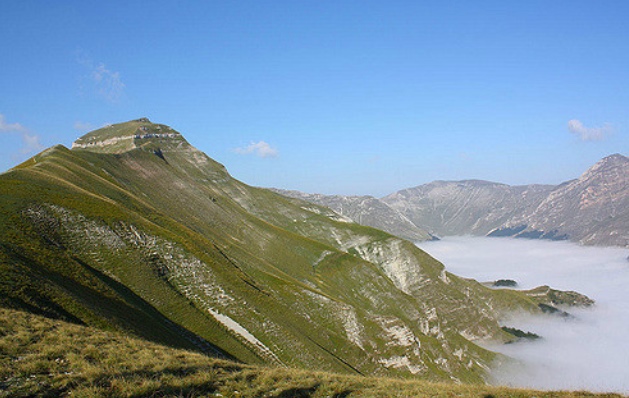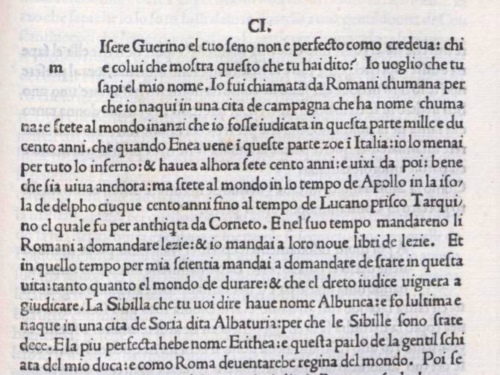16 Jul 2018
A Sibyl called Cimmerian: exploring the potential link to the Apennine Sibyl - 12. The path towards the true origin of the sibilline myth
We made a long journey throughout the centuries in search of the fourth Sibyl, the Cimmerian. We started from Francesco Maurolico, a sixteenth-century Sicilian abbot, and we went as far back as Lucius Caecilius Firmianus Lactantius and other classical Latin and Greek authors including Silius Italicus, Sextus Pompeius Festus, Pliny the Elder, Lycophrone of Chalcis, Sextus Aurelius Victor, Publius Vergilius Maro, St. Justin Martyr and Strabo. We have perused the works of Andrea da Barberino, Filippo Barbieri, the Muslim astronomer Albumazar, the fifteenth-century “Oracula Sibyllina”, and excerpts from later authors such as Juan Luis Vives, Michel Antoine Baudrand and Cesare Orlandi.
We have demonstrated that all the clues which refer to the Cimmerian Sibyl lead to Cumae, in the Italian province of Campania. Only abbot Francesco Maurolico seems to depart from this unanimous view, as he alone asserts that the fourth Sibyl, the Cimmerian, is in truth the Apennine Sibyl of Norcia.
At the present stage of our search, we do not have any clue as to why Maurolico (and apparently only Maurolico) holds such a belief. We could not retrieve any other earlier literary source conveying the same idea.
However, some pattern begins to appear amid the literary works, excerpts, passages, and mentions providing references to the world of the sibilline oracles: the Apennine Sibyl seems to present some kind of veiled, undeciphered connection to the Cumaean / Cimmerian Sibyl, as assumed by Andrea da Barberino in his fifteenth-century romance “Guerrino the Wretch” and Francesco Maurolico in his “Topographia”.
That is, some cryptic link is apparently arising between the Apennines, set in the vicinity of Norcia, and Cumae.
We still don't know what this relation might be. Better than that, we already hold a specific idea on this highly fascinating subject, but this idea is still untold. An obscure surmise which “The Apennine Sibyl - A Mystery and a Legend” will reconsider and develop in future articles, not yet published.
For the time being, we are leaving the reader with the suggestions connected to the ancient, long-vanished town of the Cimmerians, with all its mysterious spell that has bewitched men of letters of all times. A mystery we have tried to shed light upon, by walking the narrow paths traced by many authors of essays, romances and poems throughout many centuries.
An arcane travel which we want to conclude with the words written by the greatest poet of all, Homer, in his epic poem “Odyssey”. There, in Book 11, he speaks of the gloomy mystery of the Cimmerians:
«She [Odysseus' ship] came to deep-flowing Oceanus, that bounds the Earth, where is the land and city of the Cimmerians, wrapped in mist and cloud. Never does the bright sun look down on them with his rays either when he mounts the starry heaven or when he turns again to earth from heaven, but baneful night is spread over wretched mortals».
Odysseus lands «to the place of which Circe had told us»: «the house of Hades», where he performs the most frightful of all rites, the summoning of the dead from the Underworld, a gloomy ritual known as 'nekya'.
The Apennine Sibyl, the Cumaean Sibyl, the Cimmerian Sibyl, the Underworld. A legendary mystery that appears to be rooted in the deepest recesses of time, and human mind.
Una Sibilla chiamata Cimmeria: un'investigazione sulla possibile relazione con la Sibilla Appenninica - 12. Il cammino verso la vera origine del mito sibillino
Abbiamo compiuto un lungo viaggio attraverso i secoli alla ricerca della quarta Sibilla, la Cimmeria. Siamo risaliti da Francesco Maurolico, un abate siciliano vissuto nel sedicesimo secolo, fino a Lucio Cecilio Firmiano Lattanzio e ad altri autori latini e greci della classicità, tra i quali Silio Italico, Sesto Pompeo Festo, Plinio il Vecchio, Licofrone di Calcide, Sesto Aurelio Vittore, Publio Virgilio Marone, San Giustino Martire e Strabone. Abbiamo consultato i volumi di Andrea da Barberino, di Filippo Barbieri e dell'astronomo islamico Albumazar, e poi i quattrocenteschi "Oracula Sibillina" e brani tratti da autori più recenti quali Juan Luis Vives, Michel Antoine Baudrand e Cesare Orlandi.
Abbiamo dimostrato come tutti gli indizi connessi alla Sibilla Cimmeria conducano a Cuma, nella regione italiana della Campania. Solamente l'abate Francesco Maurolico pare distaccarsi da questa visione del tutto unanime, in quanto egli solo asserisce come la quarta Sibilla, la Cimmeria, sia in realtà la Sibilla Appenninica di Norcia.
Allo stadio attuale della nostra ricerca, non possiamo stabilire per quale motivo Maurolico (e, in tutta apparenza, solamente Maurolico) attesti questa posizione. Non è stato per noi possibile rintracciare alcuna ulteriore, e precedente, fonte letteraria che sostenga questa medesima idea.
Eppure, una flebile traccia sembra apparire tra le opere, i brani, i passaggi e le citazioni che si riferiscono al mondo degli oracoli sibillini: la Sibilla Appenninica pare presentare un qualche tipo di velato, indecifrabile collegamento con la Sibilla Cumana / Cimmeria, così come attestato da Andrea da Barberino nel romanzo quattrocentesco "Guerrin Meschino" e da Francesco Maurolico nella propria "Topographia".
In altre parole, una qualche sorta di nesso indistinto, enigmatico si starebbe delineando tra gli Appennini, che si ergono in prossimità di Norcia, e Cuma.
Ancora non sappiamo in cosa possa consistere esattamente questa relazione. O, meglio, abbiamo già una specifica idea in merito a questa tematica così altamente affascinante, ma questa idea è ancora inespressa. Un'ipotesi oscura, che "Sibilla Appenninica - Il Mistero e la Leggenda" ha intenzione di approfondire e sviluppare in futuri articoli, non ancora pubblicati.
Per il momento, vogliamo lasciare il lettore con le suggestioni legate all'antica città, da lungo tempo perduta, dei Cimmèri, con tutto il suo fascino misterioso e arcano, in grado di avvincere poeti e letterati di ogni epoca. Un mistero sul quale abbiamo tentato di gettare luce, percorrendo gli stretti sentieri tracciati da una pluralità di autori di saggi, romanzi e poemi nel corso di molti secoli.
Un viaggio arcano che vogliamo concludere con le parole scritte dal più grande poeta di ogni tempo, Omero, nella sua "Odissea". Qui, nel Libro 11, egli così ci racconta del tenebroso mistero dei Cimmèri:
«Essa [la nave di Ulisse] ai confini arrivò dell'Oceano corrente profonda, là dei Cimmèri è il popolo e la città, di nebbia e nube avvolti. Mai su di loro il sole splendente guarda coi raggi, né quando sale verso il cielo stellato, né quando verso la terra ridiscende dal cielo, ma notte tremenda grava sui mortali infelici».
Ulisse approda «al luogo che indicò Circe»: «la casa dell'Ade», presso cui egli effettua il più spaventoso dei riti, l'evocazione dei morti dall'Oltretomba, la cosiddetta 'nekya'.
Sibilla Appenninica, Sibilla Cumana, Sibilla Cimmeria, il mondo sotterraneo dei morti. Un mistero leggendario che pare trovare le proprie origini nei più nascosti recessi del tempo, e della mente umana.
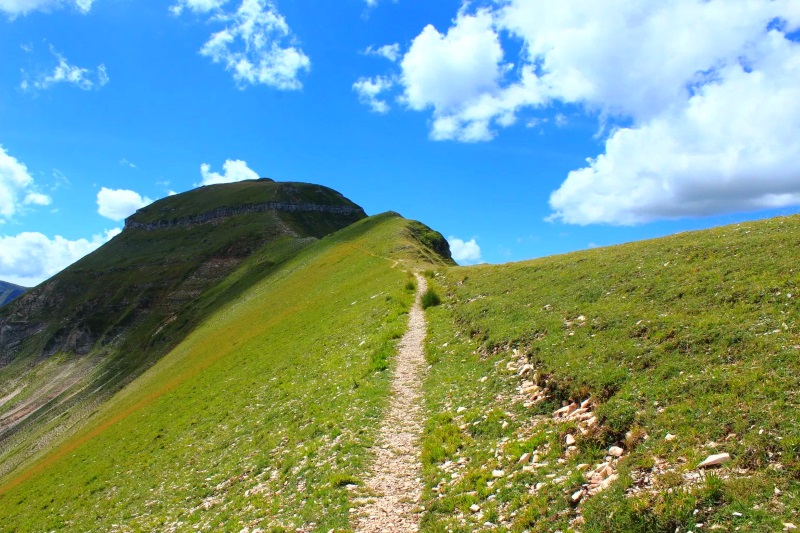

15 Jul 2018
A Sibyl called Cimmerian: exploring the potential link to the Apennine Sibyl - 11. It's a long way from the Cimerian Sibyl to the Apennines
When we began our investigation into the myth of the Cimmerian and Cumaean Sibyl, we started by considering a number of excerpts written by Francesco Maurolico in 1568.
In his “Topographia Sanctorum Christi Martyrum”, Maurolico states the following:
«The fourth Sibyl is the Cumaeam, whom Naevius mentions in his books about the Punic war, and Piso in his annals as well; from the Cimeriam castle, also known as the Cave of Norcia, which some call by the corrupted name of 'Cymea' or 'Cymica' [...] Cumae, a town of Campania lying by the gulf of Baiae. Here was the Cumaean Sibyl, who was also called Deiphobe, and by some named as Cimmeria or Cymica, but in truth the latter is a different one in the cavern of Norcia [....] Ameria, an Italian town set in the Sabine region. From this town the author names the 'Emerian Sibyl', who others call the 'Cimeriam' owing to the uncertainty of the place; she lives in the caverns of Norcia, and is different from both the Cumaean and the Tiburtine Sibyls».
When we started our exploration, we sensed that some kind of confusion affected Maurolico's words, with all his manifest efforts to corroborate the idea that the Apennine Sibyl, whose legend pertains to a cavern located in the mountains raising in the vicinity of Norcia, in central Italy, should be identified with the fourth Sibyl in Lactantius' list, the Cimmerian.
Is Maurolico right?
The right answer is no. And possibly, from a certain point of view, yes.
Maurolico is right when he says that the Cimmerian or Cumeam or Chemical Sibyl, the fourth Sibyl (see Fig .1), belongs to Cumae, as we ourselves have fully shown by our investigation. However, he is inconsistent when he says that the Cumaean is truly the Cimmerian, while in another passage he writes that the Cimmerian «is different from [...] the Cumaean»:
In addition to that, he is wrong when he expresses all his confidence in the unfounded assumption that the Sibyl of Norcia is Lactantius' Cimmerian Sibyl, the fourth sibilline oracle in the list, basing his surmise on the name of a village allegedly set by the Cave of Norcia, whose name is - according to Maurolico - 'Cimerian' or “Ameria'.
However, Maurolico's assumption is totally wrong. Because we have fully demonstrated that, in the antique tradition, the town of the Cimmerians was consistently situated by all ancient writers in Cumae, in the Italian province of Campania. Thus, Cimmerians had nothing to do with the Apennines, and equally they had nothing to do with Norcia. And the fourth Sibyl, the Cimmerian oracle, is not a Sibyl from Norcia, but a Sibyl from Cumae, as positively stated by all available classical authors.
Why did Maurolico incur this error?
His misleading statements appear to be the more perplexing when we consider that the identification of Cumae as the original place in which the fourth Cimmerian Sibyl vaticinated was not an unknown feature in Maurolico's times. Scholars of both his and later ages read the classical authors as we do today, and they found out the same pieces of information as we were able to retrieve in our present days: the Cimmerians lived by Cumae, and they had their prophesying Sibyl, who was called 'Cimmerian' after their own name.
Let's take, for instance, a commentary written in 1523 by Juan Luis Vives, a great sixteenth-century Spanish scholar, a book published in Antwerp in 1576 (Fig. 2). In commenting a famous excerpt drawn from Augustine of Hippo's “The City of God” (Book XVIII, Chapter XXIII), in which Augustine enlists the Sibyls as pagan heralds of the Salvation, Juan Luis Vives reports the famous list of ten Sibyls originally contained in Lactantius' “Divinae Institutiones”.
But, when he gets to the fourth Sibyl, he quotes the words by Lactantius with the addition of a highly remarkable sentence:
«The fourth [Sibyl is] Cumaean in Italy, whom Naevius mentions in his book on the Punic war, and Piso in his annals. Some call her Italian, from the Cimmerian town which is not far from Cumae in the Campania province».
[In the original Latin text: «Quarta [Sibylla est] Cumaea in Italia, quam Naevius in libris belli Punici, Piso in annalibus nominat. Hanc alij Italicam nuncupant, ex Cimerio Campaniae vicino Cumis oppido»].
Juan Luis Vives could not have been clearer than that: the fourth Sibyl is an Italian oracle from a small town near Cumae. And the town's name - as we know from antique authors - is Cimmerian.
And let's consider another work released a century later, the “Lexicon Geographicum” (“Geographical Dictionary”) published by a French scholar, Michel Antoine Baudrand, in 1652 (Fig. 3). Under letter 'C', we find another clear reference to the town of the Cimmerians:
«Cimmerians, population of Campania, in the vicinity of Baiae and the lake of Avernus, whose town was called Cimmerian, where the Sibyl's cave is, 'la grotta della Sibilla' [in Italian], 1 mile from Baiae and 3 miles from Pozzuoli».
[In the original Latin text: «Cimmerij item, pop. Campaniae, apud Baias et lacum Avernum, quorum opp. Cimmerium fuit, ubi antrum Sibyllae, 'la grotta della Sibilla', a Baiis 1 a Puteolis 3 milia passuum»].
Again, in the seventeenth century too the Cimmerians were placed in the vicinity of Lake Avernus, very far from central Apennines, where Norcia lies.
And here is another interesting example coming to us from a century later. In 1767, an Italian nobleman and scholar, Cesare Orlandi, who was born in an Umbrian town and whose family originated from the province of Marche, published an updated edition of a famous work, the “Iconologia”, originally edited by Cesare Ripa in 1593 (Fig. 4). In his own revised edition, Cesare Orlandi included a whole section on Sibyls, and the following is what he wrote on the Cimmerian:
«Cumean Sibyl, or Cimmerian: [...] she was born in Cumae, or in a Cimmerian village in the surroundings of Cumae, in the countryside of Naples. Many call her Italic, and it is reputed that she was vaticinating in Italy after the great fire of Troy; and of her, with full reason, we can reckon that she is the same as the Cumaean. Actually many authors report that this Sibyl was the Cumaean, to whom Vergilius pretends his characters turned for advice in Book 6 of his "Aeneid"».
[In the original Italian text: «Sibilla Cumea, ovvero Cimmeria: [...] Sibilla Cumea, ovvero Cimmeria: [...] Costei nacque in Cuma, o in Cimmerio paese vicino a Cuma nella Campagna di Napoli. Da molti è chiamata Italica, e si crede che abbia vaticinato in Italia poco dopo l'incendio di Troia; e di questa con tutta ragione si può pensare che fosse la stessa che la Cumana. Di più, non pochi riferiscono, che fosse Costei quella Sibilla, alla quale finge Virgilio nel lib. 6 'Eneid.' di esser ricorso per consiglio»].
Does Cesare Orlandi write that the Cimmerian Sibyl has any connection with a Sibyl in Norcia? Not at all. And this fact is of remarkable significance: because Cesare Orlandi was born in Città della Pieve, an Umbrian town, and his family came from Fermo, in the Marche region; if any relation had really existed between the Cimmerian and a Sibyl from Norcia - a town sitting between Umbria and Marche - Orlandi would certainly know, and would certainly tell. But he does not.
Thus, no doubt can still remain as to whether late-Renaissance scholars and later men of letters were fully informed about the true origin of the Cimmerian Sibyl: they knew that she had vaticinated in the area of Cumae, and no relation to the Apennines could be established in any way.
Definitely, Maurolico proves to be on the wrong side. But why was he so confident in his belief that the Apennine Sibyl was Lactantius' fourth Sibyl?
Though we have no conclusive information on that specific aspect, we will try to end our search with a few final consideration, which we will state in the next (and last) article.
Una Sibilla chiamata Cimmeria: un'investigazione sulla possibile relazione con la Sibilla Appenninica - 11. Lunga è la strada dalla Sibilla Cimmeria agli Appennini
Quando abbiamo cominciato la nostra investigazione attraverso il mito delle Sibille Cimmeria e Cumana, abbiamo preso le mosse da una serie di brani scritti da Francesco Maurolico nel 1568.
Nella sua “Topographia Sanctorum Christi Martyrum”, Maurolico si esprimeva nel seguente modo:
«La quarta Sibilla è la Cumea, di cui parla Nevio nei suoi libri dedicati alla Guerra Punica, a anche Pisone nei propri annali; dal castello Cimerio, conosciuto anche con il nome di Antro nursino, che alcuni chiamano con il nome corrotto di 'Cymea' o 'Cymica' [...] Cuma, città della Campania nel golfo di Baia. Qui fu la Sibilla Cumana, chiamata anche Deifobe, che alcuni indicano come Cimmeria o Cymica, se questa non fosse un diverso oracolo posto nella caverna di Norcia [...] Ameria, città dell'Italia posta nella regione Sabina. Da questa città l'autore denomina la 'Sibilla Emeria', che altri chiamano 'Cimeria' a causa dell'incertezza sul luogo; essa vive nell'antro di Norcia, ed è diversa sia dalla Cumana che dalla Tiburtina [...]».
Quando la nostra ricerca ha avuto inizio, non abbiamo potuto evitare di pensare che le parole di Maurolico fossero affette da un qualche genere di confusione, essendo evidente il suo palese tentativo di avallare l'idea che la Sibilla Appenninica, la cui leggenda riguarda una grotta collocata tra le montagne che si innalzano in prossimità di Norcia, nell'Italia centrale, dovesse essere identificata con la quarta Sibilla elencata nella lista di Lattanzio, la Cimmeria.
Ma Maurolico era veramente nel giusto?
La risposta corretta è no. E, forse, da un certo punto di vista, anche sì.
Maurolico, infatti, ha ragione quando afferma che la Sibilla Cimmeria o Cumea o Chimica, la quarta Sibilla (Fig. 1), appartiene a Cuma, come noi stessi abbiamo potuto dimostrare per mezzo della nostra investigazione. Invece, egli risulta essere in tutta evidenza inconsistente quando dichiara che la Cimmeria «è diversa [...] dalla Cumana».
Inoltre, egli prende un abbaglio quando manifesta di voler riporre ogni sua certezza nell'infondata ipotesi che la Sibilla di Norcia possa essere la Sibilla Cimmeria di Lattanzio, il quarto oracolo sibillino contenuto nell'enumerazione classica, basando la propria convinzione sul nome di un villaggio che esisterebbe nelle vicinanze della Grotta di Norcia, e il cui nome sarebbe - secondo Maurolico - 'Cimerio' o 'Amerio'.
Questa affermazione di Maurolico è totalmente errata. Abbiamo infatti pienamente dimostrato come, nella tradizione antica, la città dei Cimmèri fosse unanimemente collocata, da tutti gli autori classici, presso Cuma, nella provincia italica della Campania. Dunque, i Cimmèri non avevano nulla a che fare con gli Appennini, e parimenti nulla avevano a che fare con Norcia. E la quarta Sibilla, la Cimmeria, non è affatto una Sibilla di Norcia, ma una Sibilla di Cuma, come positivamente e indubitabilmente affermato da tutti i riferimenti testuali classici oggi disponibili.
Ma perché Maurolico cadde in questo errore?
Le sue fuorvianti affermazioni appaiono suscitare ancor maggiore perplessità quando si consideri che l'identificazione di Cuma come luogo originale presso il quale la quarta Sibilla, Cimmeria, vaticinava non costituiva affatto informazione ignota ai contemporanei di Maurolico. Gli studiosi del suo tempo e dei secoli successivi, infatti, erano in grado di leggere i testi degli antichi autori esattamente come noi facciamo oggi, e potevano reperire gli stessi elementi informativi che anche noi abbiamo potuto ritrovare ai nostri giorni: i Cimmèri vivevano a Cuma, e disponevano di una propria Sibilla oracolare, che era chiamata 'Cimmeria', traendo il proprio nome dall'appellativo stesso di quel popolo.
Prendiamo, ad esempio, un'opera scritta nel 1523 da Juan Luis Vives, un noto erudito spagnolo del sedicesimo secolo, un libro pubblicato in Anversa nel 1576 (Fig. 2). Nel commentare un famoso brano tratto da "La Città di Dio" di Agostino di Ippona (Libro XVIII, Capitolo XXIII), nel quale Agostino arruola le Sibille tra gli araldi pagani della Salvezza, Juan Luis Vives cita la famosa lista di dieci Sibille originariamente contenuta nelle "Divinae Institutiones" di Lattanzio.
Ma, quando egli arriva alla quarta Sibilla, Vives riferisce le parole di Lattanzio aggiungendo ad esse una frase ben significativa:
«La quarta [Sibilla è] la Cumea in Italia, di cui parla Nevio nei libri dedicati alla Guerra Punica, e anche Pisone nei propri annali. Alcuni la chiamano Italica, dalla città dei Cimmèri posta in prossimità di Cuma in Campania».
[Nel testo originale latino: «Quarta [Sibylla est] Cumaea in Italia, quam Naevius in libris belli Punici, Piso in annalibus nominat. Hanc alij Italicam nuncupant, ex Cimerio Campaniae vicino Cumis oppido»].
Juan Luis Vives non avrebbe potuto essere più chiaro: la quarta Sibilla è un oracolo italiano attivo in una piccola città posta presso Cuma. E l'appellativo della città - come già sappiamo dalle fonti antiche - è Cimmeria.
E proviamo a considerare un'altra opera diffusa nel secolo successivo, il “Lexicon Geographicum”, pubblicato da uno studioso francese, Michel Antoine Baudrand, nel 1652 (Fig. 3). Sotto la lettera 'C', troviamo un ulteriore, chiarissimo riferimento alla città dei Cimmèri:
«Cimmèri, popolazione della Campania, nell'area di Baia e del Lago d'Averno, la cui città fu chiamata Cimmeria, presso cui si trova l'antro della Sibilla, 'la grotta della Sibilla', 1 miglio da Baia e 3 miglia da Pozzuoli».
[Nel testo originale latino: «Cimmerij item, pop. Campaniae, apud Baias et lacum Avernum, quorum opp. Cimmerium fuit, ubi antrum Sibyllae, 'la grotta della Sibilla', a Baiis 1 a Puteolis 3 milia passuum»].
Ed ecco che, di nuovo, anche nel diciassettesimo secolo i Cimmèri venivano posizionati presso il Lago d'Averno, quindi molto lontano dall'Appennino umbro-marchigiano, dove si trova Norcia.
Ed ecco un ulteriore interessantissimo esempio, a noi proveniente dal secolo ancora successivo. Nel 1767, un aristocratico ed erudito italiano, Cesare Orlandi, nato in una città dell'Umbria e la cui famiglia era originaria delle Marche, pubblicò una edizione aggiornata di un'opera molto rinomata, il cui titolo era "Iconologia", originariamente data alle stampe da Cesare Ripa nel 1593 (Fig. 4). Nella propria edizione riveduta e ampliata, Cesare Orlandi inserì anche un'intera sezione dedicata alle Sibille, ed ecco ciò che egli scrisse a proposito della Cimmeria:
«Sibilla Cumea, ovvero Cimmeria: [...] Costei nacque in Cuma, o in Cimmerio paese vicino a Cuma nella Campagna di Napoli. Da molti è chiamata Italica, e si crede che abbia vaticinato in Italia poco dopo l'incendio di Troia; e di questa con tutta ragione si può pensare che fosse la stessa che la Cumana. Di più, non pochi riferiscono, che fosse Costei quella Sibilla, alla quale finge Virgilio nel lib. 6 'Eneid.' di esser ricorso per consiglio».
Cesare Orlandi ha forse scritto che la Sibilla Cimmeria presenta una qualsivoglia connessione con una Sibilla degli Appennini? Niente affatto. E, in effetti, questo elemento appare essere estremamente significativo: perché Cesare Orlandi era nato a Città della Pieve, città dell'Umbria, e la sua famiglia proveniva da Fermo, nelle Marche: se una qualsiasi relazione fosse realmente esistita tra la Cimmeria e una Sibilla di Norcia - città posta esattamente tra l'Umbria e le Marche - Orlandi lo avrebbe certamente saputo, e lo avrebbe sicuramente riferito e scritto. Ma egli non lo fa.
Dunque, nessun dubbio può ancora sussistere in merito al fatto che gli eruditi e gli studiosi del tardo Rinascimento, nonché i letterati dei secoli successivi, avessero piena cognizione della reale origine della Sibilla Cimmeria: essi sapevano che quell'oracolo aveva reso i propri vaticini nell'area di Cuma, e che non esisteva alcun motivo o ragione per collegare in alcun modo quella Sibilla con la catena degli Appennini.
È quindi un dato di fatto che Maurolico risulta trovarsi dal lato del torto. Ma come è possibile che egli si dichiari così sicuro della propria convinzione a proposito dell'identificazione tra Sibilla Appenninica e quarta Sibilla di Lattanzio?
Benché non disponiamo attualmente di alcuna informazione decisiva in merito a questa specifica questione, tenteremo comunque di concludere la nostra ricerca con alcune considerazioni finali, che andremo a esplicitare nel prossimo (e ultimo) articolo.
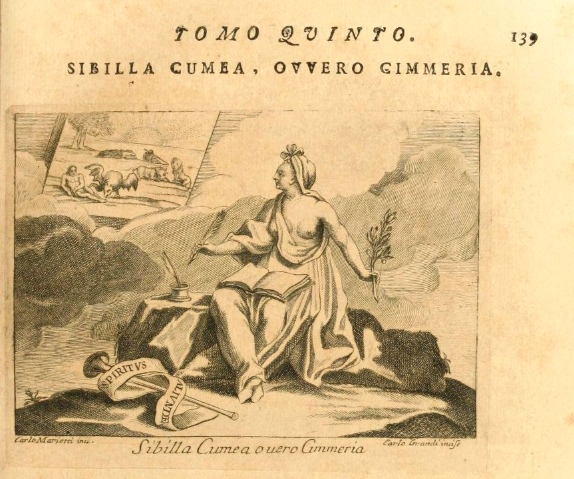

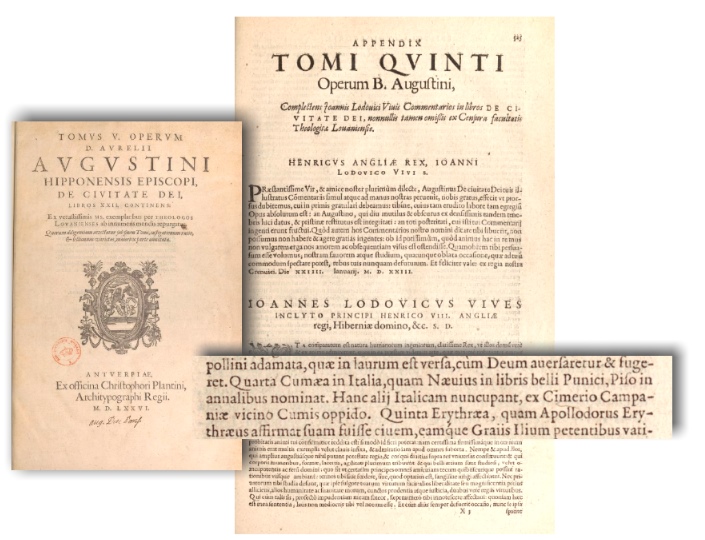

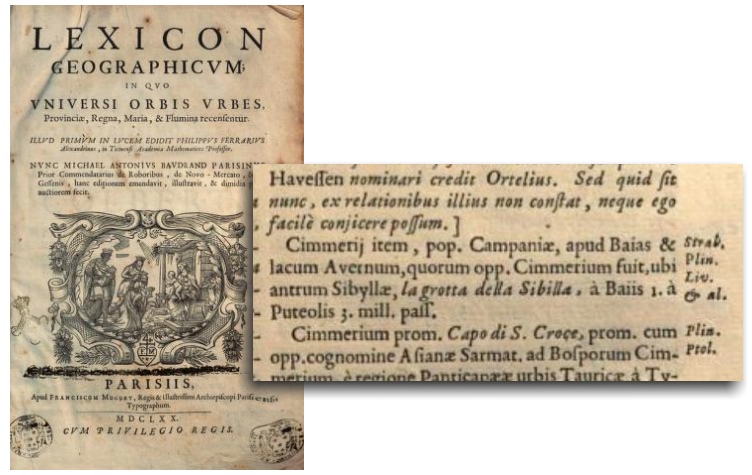

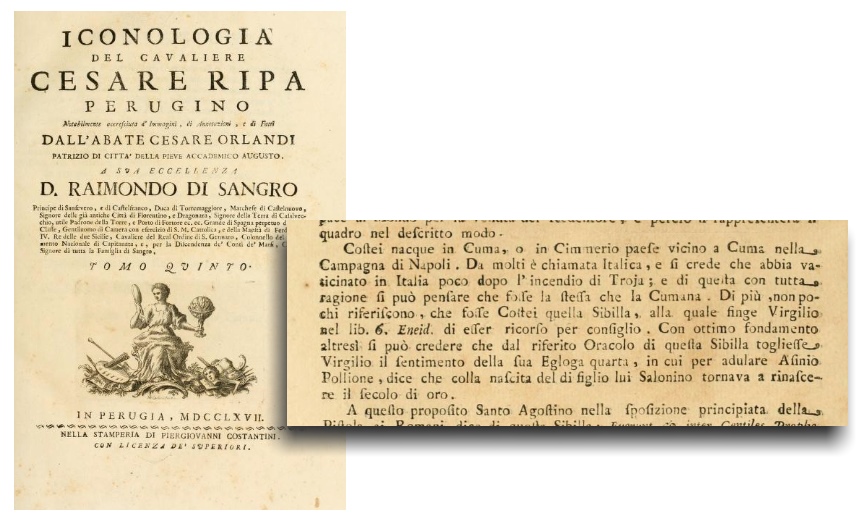

12 Jul 2018
A Sibyl called Cimmerian: exploring the potential link to the Apennine Sibyl - 10. The Cimmerian Sibyl as an earlier Cumaean
When the Roman Empire was flourishing, the Cimmerians too had already become a legendary population long vanished from the sight of history, just like the Cumaean Sibyl who had disappeared centuries earlier. For the Romans themselves, Cimmerians were but a faint recollection: a legendary population whose subterranean abode once concealed by the Lake Avernus was extant nomore already in the early Roman age. Not the least remnant of their subterranean dwellings and tunnels is to be found in our present days, and the more so if we consider the destructive earthquakes that have repeatedly been striking the area of Lake Avernus and the Phlegraean Fields across the centuries (for instance, let's consider the 1538 earthquake when a small volcano, Monte Nuovo, was generated in a handful of days).
Despite all that, Strabo, who writes in the first century, reports an additional, remarkable detail (Fig. 2):
«Later on the Cimmerians were destroyed by a certain king, because the response of the oracle did not turn out in his favour; the seat of the oracle, however, still endures, although it has been removed to another place».
[In the Latin translation from the original Greek text: «postea temporis Cimmerios fuisse deletos a rege quodam, cuius eventa oraculum non comprobassent, sedem oraculi alio translatam etiamnun durare»].
According to Strabo, at his age Cimmerians had already been wiped out centuries earlier. In another passage we already quoted, it's Strabo himself who adds that «Ephorus maintained that this site was of the Cimmerians, about whom he says that they dwell in underground premises» [«Ephorus vero Cimmeriis locum illum dicans, hos abitare ait in subterraneis aedificiis» in Latin]. And Ephorus was a local historian, who lived in Cumae during the fourth century B.C. (his books no longer exist).
This means that Cimmerians vanished from Lake Avernus centuries and centuries before the arrival of the Romans in Cumae, but «the seat of the oracle, however, still endures, although it has been removed to another place».
Could it be that the Cimmerian Sibyl, who provided her responses in an underground site in Cumae by querying the dead through necromantic practices, had subsequently moved to another shrine, again situated in the town of Cumae, following the destruction of her original site, and that the Sibyl at the new site had taken the name of 'Cumaean'?
Could it be that the original, antique Cimmerian Sibyl had taken on the final name of 'Cumaean Sibyl', after having abandoned her former subterranean site, following its obliteration?
According to many scholars, the answer is positive. Jacques Hergon, a renowned French latinist, and other researchers (Luca Antonelli) consider the Cimmerian Sibyl as an early prophetess providing responses in the area of Cumae, by querying the dead through necromancy. Later on, after the destruction of her original underground shrine, the oracle moved to another temple in downtown Cumae, assuming the name of 'Cumaean Sibyl', providing her prophecies by writing them on a multiplicity of oak leaves, and then letting the leaves whirl freely in the whiffs of the wind («volent rapidis ludibria ventis», as Vergilius says), so as to render the oracular response almost incomprehensible.
So, the Cimmerian Sibyl and the Cumaean Sibyl would actually be the same prophetess, the former being only an earlier name for the latter.
This identity would provide a full explanation for the suspicious confusion in the names attributed to the fourth Sibyl which arises in different versions of the list stated by Lactantius: 'Cimmeriam' in some of them, and 'Cumeam' in other manuscripts. In the suggested theory, the fourth Sibyl would be just identical to the seventh, the Cumaeam, but called by her original, more ancient name.
And another peculiar literary intricacy, connected to the description of the Cumaean Sibyl provided by Vergilius in his “Aeneid”, would find its correct solution.
In Book VI, Vergilius says that, after arriving in Cumae, «Aeneas the pious ascends the citadel which is ruled by glorious Apollo and heads to the ghastly, secret recesses, the huge cavern of the Sibyl» («pius Aeneas arces, quibus altus Apollo presidet horrendaque procul secreta Sibyllae antrum immane petit» in Latin). He is visiting what is to be identified with the Cumaean Sibyl, who provides her responses acting as the voice of Greek deity Apollo:
«Such reins Apollo shakes in the body of the frenzied prophetess, and such spurs he urges in her heart».
[In the original Latin text: «ea frena furenti concutit et stimolos sub pectore vertit Apollo»].
But then, later in the same Book, the Sibyl commands Aeneas to make an offering to Hecate, the Greek goddess associated to witchcraft and necromancy, and the rite is carried out at a cave by the Lake Avernus. Now, the Sibyl has taken on the full attributes of the older Cimmerian prophetess:
«A deep cave was there, with a huge, frighful opening, hard to reach, protected by the gloomy lake and the darkness of the woods [... Aeneas] put the offerings on the sacred fire, a prominent donation, appealing to Hecate by his voice, calling to the heaven and to vast Erebus».
[In the original Latin text: «Spelunca alta fuit vastoque inmanis hiatu, scrupea, tuta lacu nigro nemoremque tenebris [...] ignibus imponit sacris, libamina prima, voce vocans Hecaten caeloque Ereboque potentem»].
In the above excerpts, Vergilius would be just portraying the two aspects of the Cimmerian / Cumaean Sibyl: the necromantic prophetess (Cimmerian) and the oracle of Apollo (Cumaean). Two different aspects for the same Sibyl: the Sibyl of Cumae.
A Sibyl who re-emerges from the mists of a lost, almost forgotten past, as portrayed in a most precious illuminated manuscript (Vat. Lat. 3225) preserved at the Vatican Apostolic Library in Rome: one of the most ancient manuscripted relics coming to us from the classical Roman world, dating back to the fourth century and featuring a stunning picture of Aeneas and his comrade Achates as they stand before the Cumaean Sibyl and her shrine dedicated to Apollo (Fig. 1).
We are getting closer and closer to the end of our amazing journey into myth and sibilline lore. Time has come now to provide an answer to the initial question we had posed at the very beginning of our travel: is the Apennine Sibyl, the Sibyl of Norcia, connected in any way to the Cimmerian Sibyl, as alleged by a sixteenth-century abbot from Sicily, Francesco Maurolico, in his “Topographia Sanctorum Christi Martyrum”?
The answer seems now to be clear. And we will detail it in the next article.
Una Sibilla chiamata Cimmeria: un'investigazione sulla possibile relazione con la Sibilla Appenninica - 10. La Sibilla Cimmeria, antecedente della Cumana
Quando l'Impero Romano giungeva all'apice della propria potenza, anche i Cimmèri erano già divenuti un popolo leggendario, svanito da tempo dal teatro della storia, proprio come accaduto anche alla Sibilla Cumana, scomparsa già da molti secoli. Per gli stessi Romani, i Cimmèri non costituivano altro che un flebile ricordo: una popolazione leggendaria, le cui dimore sotterranee, un tempo celate in prossimità del Lago d'Averno, non esistevano già più sin dall'epoca in cui Roma era ancora giovane. Ai nostri giorni, nemmeno le più insignificanti vestigia di quelle residenze occultate nella terra, né di quei tunnel, possono essere più rintracciate in alcun modo, e questa impossibilità risulta essere tanto più evidente quando si considerino i terremoti e gli eventi catastrofici che hanno ripetutamente colpito il Lago d'Averno e i Campi Flegrei nel corso dei secoli (pensiamo, ad esempio, al sisma del 1538, in concomitanza del quale un piccolo vulcano, il Monte Nuovo, si innalzò dalla terra nel corso di una manciata di giorni).
Malgrado ciò, Strabone, che scrive nel primo secolo, ci rende disponibile un dettaglio aggiuntivo di grande rilevanza (Fig. 2):
«Successivamente i Cimmèri furono distrutti da un certo re, al quale i responsi oracolari non risultarono graditi; ma la sede dell'oracolo esiste ancora oggi, benché essa sia stata trasferita in altro luogo».
[Nella traduzione latina dall'originale greco: «postea temporis Cimmerios fuisse deletos a rege quodam, cuius eventa oraculum non comprobassent, sedem oraculi alio translatam etiamnun durare»].
Secondo quanto riferisce Strabone, ai suoi tempi i Cimmèri erano stati già spazzati via secoli prima. In un altro passaggio da noi già menzionato, è lo stesso Strabone ad aggiungere che «Eforo riteneva che fosse questo il luogo dei Cimmèri, a proposito dei quali egli affermava che risiedessero in dimore sotterranee» [«Ephorus vero Cimmeriis locum illum dicans, hos abitare ait in subterraneis aedificiis» in latino]. Ed Eforo era uno storico locale, che visse a Cuma nel corso del quarto secolo a.C. (le sue opere purtroppo non esistono più).
Ciò significa che i Cimmèri svanirono dallla zona del Lago d'Averno secoli e secoli prima dell'arrivo dei romani a Cuma, ma «la sede dell'oracolo esiste ancora oggi, benché essa sia stata trasferita in altro luogo».
È possibile ipotizzare che la Sibilla Cimmeria, la quale forniva responsi oracolari presso un sito sotterraneo nell'area di Cuma, interrogando i morti tramite pratiche negromantiche, abbia subìto un trasferimento presso un altro e diverso santuario, situato nella medesima area cumana, a seguito della distruzione della propria sede originale, e che il nome assunto dalla Sibilla nel nuovo sito sia proprio 'Cumana'?
È possibile che l'antica, originale Sibilla Cimmeria abbia acquisito il nome finale di 'Sibilla Cumana', dopo l'abbandono del proprio precedente sito sotterraneo, a causa dell'obliterazione dello stesso?
Secondo molti studiosi, la risposta a queste domande sarebbe positiva. Jacques Hergon, un celebre latinista francese, e altri ricercatori (Luca Antonelli) considerano la Sibilla Cimmeria come la più antica profetessa attiva nell'area cumana, operante con tecniche di tipo negromantico. In seguito, dopo la distruzione del tempio sotterraneo originale, l'oracolo si sarebbe trasferito in un diverso sito posto nell'area centrale di Cuma, assumendo il nome di 'Sibilla Cumana' e rendendo le proprie profezie mediante scrittura di vaticini eseguita su di una pluralità di foglie di quercia, abbandonate poi al libero gioco del vento («volent rapidis ludibria ventis», come racconta Virgilio), in modo tale da rendere il responso oracolare sostanzialmente incomprensibile.
Dunque, la Sibilla Cimmeria e la Sibilla Cumana non sarebbero altro che la medesima profetessa, la prima rappresentando semplicemente il nome più antico della seconda.
Questa identificazione sarebbe in grado di spiegare in modo del tutto esaustivo quella sospetta confusione tra i vari appellativi attribuiti alla quarta Sibilla, così come indicati nelle differenti versioni dell'antica enumerazione delineata da Lattanzio: 'Cimmeria', secondo alcune di esse, e 'Cumana' in altri manoscritti. Secondo questa ipotesi, la quarta Sibilla sarebbe fondamentalmente identica alla settima, la Cumana, ma ad essa sarebbe attribuito il nome originale e più antico.
E anche un altro peculiare enigma letterario, connesso alla descrizione della Sibilla Cumana così come proposta da Virgilio nella sua "Eneide", potrebbe trovare, in questo modo, la propria corretta soluzione.
Nel libro VI, Virgilio racconta di come, dopo il suo arrivo a Cuma, «il pio Enea ascenda la cittadella, retta dal glorioso Apollo, recandosi all'antro profondo, orrendo e appartato della Sibilla» («pius Aeneas arces, quibus altus Apollo presidet horrendaque procul secreta Sibyllae antrum immane petit» in latino). Egli sta per visitare quella che deve essere identificata come la Sibilla Cumana, la quale fornisce i propri responsi esprimendo la voce e la volontà del dio greco Apollo:
«Tali sono le redini che Apollo scuote nella furente profetessa, e tali gli speroni che il dio le urge nel petto».
[Nel testo originale latino: «ea frena furenti concutit et stimolos sub pectore vertit Apollo»].
Ma poi, successivamente, nel medesimo libro, la Sibilla ordina a Enea di presentare un'offerta a Ecate, la dea greca associata alla stregoneria e alla negromanzia, e il rituale viene posto in atto in una grotta posta presso il Lago d'Averno. Ora, la Sibilla ha assunto tutti gli attributi della più antica profetessa Cimmeria:
«Una profonda spelonca era lì, una vasta, immensa fenditura, difficile da penetrare, protetta dal lago nero e dalla tenebra delle selve [... Enea] pone l'offerta sul fuoco sacro, dono copioso, evocando Ecate con la propria voce, invocando i cieli e il vasto Erebo».
[Nel testo originale latino: «Spelunca alta fuit vastoque inmanis hiatu, scrupea, tuta lacu nigro nemoremque tenebris [...] ignibus imponit sacris, libamina prima, voce vocans Hecaten caeloque Ereboque potentem»].
Nei brani qui citati, Virgilio non starebbe facendo altro che porre in scena i due differenti aspetti della Sibilla Cimmeria / Cumana: la profetessa che si avvale di arti negromantiche (Cimmeria) e l'oracolo di Apollo (Cumana). Due diverse rappresentazioni della stessa Sibilla: la Sibilla di Cuma.
Una Sibilla che riemerge dalle nebbie di un passato perduto e quasi dimenticato, così come rappresentata nel preziosissimo manoscritto miniato dell''Eneide' (Vat Lat 3225) conservato presso la Biblioteca Apostolica Vaticana: uno dei reperti manoscritti più antichi dell'intero mondo classico romano, risalente addirittura al quarto secolo, con una stupenda immagine di Enea e del suo compagno Acate raffigurati mentre si presentano innanzi alla Sibilla Cumana e al suo tempio apollineo (Fig. 1).
Ci stiamo avvicinando sempre di più al termine del nostro incredibile viaggio attraverso il mito e le tradizioni sibilline. È giunto ora il momento di rispondere alla domanda iniziale, quella che ci eravamo posti quando abbiamo cominciato il nostro percorso: la Sibilla Appenninica, la Sibilla di Norcia, è forse collegata in qualche modo con la Sibilla Cimmeria, così come sostenuto da un abate siciliano vissuto nel sedicesimo secolo, Francesco Maurolico, nella sua “Topographia Sanctorum Christi Martyrum”?
La risposta, adesso, ci appare assolutamente chiara. E andremo ad esplicitarla nel prossimo articolo.
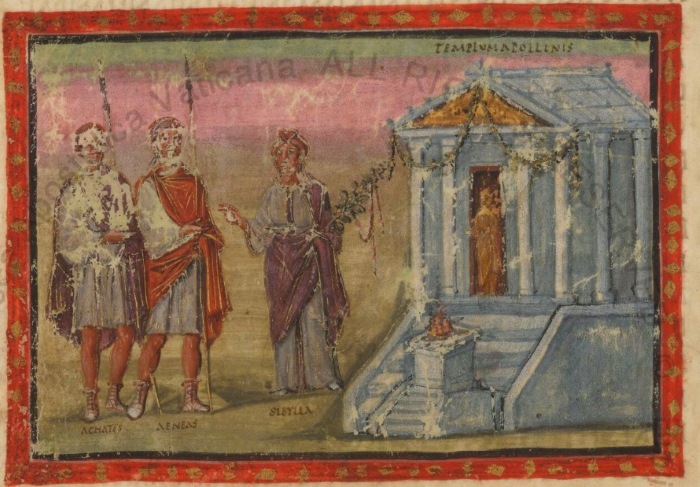



9 Jul 2018
A Sibyl called Cimmerian: exploring the potential link to the Apennine Sibyl - 9. Cumaen and Cimmerian, a single Sibyl for Cumae
Cumae, one of the most ancient Greek colonies in southern Italy, established at the mid of the eighth century B.C., a town that was regarded as sacred to ctonian deities owing to its highly peculiar volcanic nature.
As we saw already, according to the available documents describing the traditions of ancient Rome, two sibilline oracles were to be found in Cumae: the Cumaean Sibyl and the Cimmerian Sibyl (both portrayed in Fig. 1 as they appear in a most precious Book of Hours dating to year 1427, preserved at the Bibliothèque Nationale de France in manuscript Latin 920).
Were they different Sibyls? Did they have any relationship one another? And are there any visible remnants of their shrines? What do contemporary archeology and modern history research have to tell us about them?
Let's consider the most famous prophetess, the Cumaean Sibyl: the seventh oracle in Lucius Caecilius Firmianus Lactantius' classical list. She was also celebrated by Vergilius in Book 6 of “Aeneid” with masterful verses: «terrific riddles she yells, as she sings in her cave, the truth enshrouded in darkness» [«Cumaea Sibylla - horrendas canit ambages antroque remugit - obscuris vera involvens» in Latin]. And we cannot forget the amazing portrait of a withered, ever-ageing Sibyl subject to a doom of immortality, as provided to us by Publius Ovidius Naso in his “Metamorphoses”, with a final stroke being painted by Gaius Petronius Arbiter, in his “Satyricon”, in which a shrunken Cumaean Sibyl, confined in a flask, asks visitors for a merciful death.
The literary tradition on the Cumaean Sibyl seems unmistakable, and it appears to depict some sort of oracle that really existed in ancient times.
However, the topic is not so easily managed. The Sibyl's Cave discovered in Cumae by an Italian archeologist, Amedeo Maiuri, in 1932 and shown to visitors in our present days is not recognised by scholars as the veritable site where the Cumaean Siby vaticinated. No archeological evidence of such an attribution has ever been found at the place. No positive, glaring oracular site has yet been identified in the existing area of ancient Cumae.
The actual problem is that, already in antique times, the Cumaean Sibyl was not active anymore. When Vergilius, Ovidius, Petronius and Lactantius wrote their works, the Sibyl had long transfomed herself into a remote legend, lost in the mists of the past. Romans never knew nor saw this Sibyl in her actual reality, for she belonged to the long-gone Greek past of Cumae, a town which the Romans conquered in year 338 B.C., four hundred years after its foundation. Rieuwerd Buitenwerf, a Dutch scholar, says with an incisive remark on the Cumaean oracle that «its location had already been forgotten by the time Virgil visited Cumae».
In the fourth century of the Christian era, Cumae had become a celebrated attraction for turists who - just as today - wanted to see the site of the legendary Sibyl chanted by Vergilius. And sure enough the locals did not restrain themselves from telling paying visitors what they wanted to hear, as narrated in the “Exhortation to the Greeks” (Chapter 39 - see Fig. 2), a Greek text once attributed to St. Justin Martyr:
«Easily you will learn the right religion from the ancient Sibyl, who used to teach through some kind of amazing inspiration by means of oracular predictions. [...] She, they say, rendered her prophecies in a city called Cumae, six miles from Baiae (where the hot springs of Campania are found). When we arrived in this city, we saw a certain place where we discerned a huge basilica, hewn out of one rock [...] People who had received the local tradition from their own ancestors, told us that this was the very place where the prophetess used to utter her oracles. [...] When we were in the city, we learned this things ourselves from the ones who use to guide the visitors around to see the remarkable places in the area. They showed us also [...] a small artifact, made of bronze, in which they said her remains were kept».
[In the Latin translation from the original text in Greek: «Perfacile autem vobis erit rectam religionem [...] a veteri Sibylla ex afflatu quodam mirifico per sortes ac responsa vos docente percipere. [...] Eam in Campaniae [...] in urbe quadam cui Cumae nomen est, sexto a Baiis (qui locus thermas Campanas habet) lapide, oracula edidisse. Vidimus nos ea in urbe cum essemus, locum quendam, in quo ingentem basilicam, uno fabrefactam saxo contemplati sumus [...] ubi responsa eam dedisse affirmabant illi, qui res patrias a majoribus suis traditas acceperint. [...] Quin ipsi quoque, cum in ube ea essemus, indicibus, qui hospites ad ea, quae visenda sunt, ducere solent, ostendentibus [...] vidimus loculum quendam ex aere elaboratum ubi reliquias ejus servari dicebant»].
So the actual, physical reality of the Cumaean Sibyl and her shrine appears to be lost forever, and that loss had already taken place at the time when Romans won Cumae for themselves.
And now, what about the Cimmerian Sibyl? If we start considering the Sibyl of the Cimmerians, the mist of history turns out to be even thicker. Let's try to dispel it, at least partially, in the next article.
Una Sibilla chiamata Cimmeria: un'investigazione sulla possibile relazione con la Sibilla Appenninica - 9. Cumana e Cimmeria, una sola Sibilla per Cuma
Cuma, una delle più antiche colonie greche nell'Italia meridionale, fondata a metà dell'VIII secolo a.C., una città che fu considerata come sacra alle divinità ctonie a causa della peculiarissima natura vulcanica di quel territorio.
Come abbiamo avuto modo di vedere, sulla base della documentazione disponibile relativamente alle tradizioni di Roma antica, Cuma ospitava due specifici oracoli sibillini: la Sibilla Cumana e la Sibilla Cimmeria (entrambe rappresentate in Fig. 1 così come appaiono in un preziosissimo Libro delle Ore risalente all'anno 1427, conservato presso la Bibliothèque Nationale de France all'interno del manoscritto Latin 920).
Si trattava veramente di oracoli differenti? Esisteva una relazione tra di essi? Esistono ancora resti visibili dei relativi luoghi di culto? Cosa possono raccontarci oggi, di esse, l'archeologia e le moderne ricerche storiche?
Prendiamo in esame la profetessa di maggior fama, la Sibilla Cumana: il settimo oracolo, nell'elencazione classica di Lucio Cecilio Firmiano Lattanzio. Essa fu anche celebrata da Virgilio nel sesto libro dell'"Eneide", con versi immortali: «enigmi paurosi essa canta mugghiando nell’antro, la verità avvolgendo di tenebra» [«Cumaea Sibylla - horrendas canit ambages antroque remugit - obscuris vera involvens» in latino]. E non possiamo nemmeno dimenticare l'impressionante immagine di una Sibilla decrepita e soggetta ad un invecchiamento senza fine, tramandataci da Publio Ovidio Nasone nelle sue "Metamorfosi", con un tocco finale dipinto per noi da Gaio Petronio Arbitro, nel suo "Satyricon", nel quale una Sibilla Cumana ormai avvizzita e ridotta ad un essere minuscolo, confinata in un'ampolla, implora i suoi visitatori affinché le sia finalmente concessa una morte misericordiosa.
La tradizione letteraria concernente la Sibilla Cumana appare dunque indubitabile, e pare effettivamente che essa descriva una qualche tipologia di oracolo realmente esistente in tempi molto antichi.
Eppure, l'intera materia non pare affatto presentarsi come definitivamente consolidata. L'Antro della Sibilla scoperto a Cuma nel 1932 da un archeologo italiano, Amedeo Maiuri, e mostrato oggi ai turisti non è affatto riconosciuto dagli studiosi come l'autentico sito presso il quale la Sibilla Cumana rendeva i propri vaticini. Nessuna evidenza archeologica in grado di confermare questa attribuzione è stata mai reperita nei locali sotterranei. E nessun sito manifestamente, indubitabilmente oracolare è stato mai identificato nell'attuale area dell'antica Cuma.
Il vero problema, infatti, è che già nell'antichità la Sibilla Cumana non era più attiva da lungo tempo. Quando Virgilio, Ovidio, Petronio e Lattanzio scrivono le rispettive opere, la Sibilla ha già compiuto la propria trasformazione da oracolo a leggenda nebulosa e remota, perduta tra le nebbie del passato. I Romani non conobbero né videro mai questa Sibilla nella sua tangibile realtà, in quanto essa già apparteneva, ormai, al lontano passato della Cuma greca, che fu conquistata dai Romani nell'anno 338 a.C., quattrocento anni dopo la fondazione dell'insediamento. Rieuwerd Buitenwerf, uno studioso olandese, afferma con un'incisiva osservazione a proposito dell'oracolo cumano che «la sua esatta localizzazione era stata già da tempo dimenticata all'epoca in cui Virgilio visitò Cuma».
Nel quarto secolo dell'era cristiana, Cuma si era già trasformata in una rinomata attrazione per i turisti dell'epoca, i quali - esattamente come accade anche oggi - volevano visitare il luogo dove aveva profetato la leggendaria Sibilla cantata da Virgilio. E la gente del luogo non si tirava certamente indietro nel narrare ai visitatori paganti ciò che essi volevano sentirsi dire, come ci viene raccontato nell'"Esortazione ai Greci" (Capitolo 39 - vedere Fig. 2), testo in lingua greca attribuito a S. Giustino Martire:
«Facilmente apprenderai la retta religione [...] dall'antica Sibilla, che insegnò attraverso una sorta di mirabile ispirazione per mezzo di responsi oracolari [...] Si racconta di come essa rendesse le proprie profezie in una certa città chiamata Cuma, a sei miglia da Baia (dove si trovano le acque calde della Campania). Quando giungemmo in città, visitammo un certo luogo nel quale si poteva vedere una grande basilica, tagliata all'interno di una grande roccia [...] La gente, alla quale era stata tramandata questa tradizione locale dai propri avi, ci raccontò che questo era il luogo in cui la profetessa era solita pronunciare i propri oracoli. [...] Quando fummo in città, potemmo apprendere queste cose da coloro che erano soliti fare da guida ai visitatori, per mostrare loro i luoghi notevoli. [...] Ci mostrarono anche [...] un piccolo contenitore, fatto di bronzo, all'interno del quale essi affermavano che fossero ancora custoditi i suoi resti».
[Nella traduzione latina dal testo greco originale: «Perfacile autem vobis erit rectam religionem [...] a veteri Sibylla ex afflatu quodam mirifico per sortes ac responsa vos docente percipere. [...] Eam in Campaniae [...] in urbe quadam cui Cumae nomen est, sexto a Baiis (qui locus thermas Campanas habet) lapide, oracula edidisse. Vidimus nos ea in urbe cum essemus, locum quendam, in quo ingentem basilicam, uno fabrefactam saxo contemplati sumus [...] ubi responsa eam dedisse affirmabant illi, qui res patrias a majoribus suis traditas acceperint. [...] Quin ipsi quoque, cum in ube ea essemus, indicibus, qui hospites ad ea, quae visenda sunt, ducere solent, ostendentibus [...] vidimus loculum quendam ex aere elaboratum ubi reliquias ejus servari dicebant»].
E così la presenza reale, attuale della Sibilla Cumana e del suo tempio oracolare pare ormai essere andata perduta per sempre, e questa perdita aveva già avuto luogo quando i Romani conquistarono Cuma per se stessi.
E la Sibilla Cimmeria? Se adesso cominciamo a prendere in considerazione la Sibilla dei Cimmèri, le nebbie della storia non possono che apparire ancor più fitte di fronte ai nostri occhi. Proviamo a disperderle, almeno in parte, nel prossimo articolo.
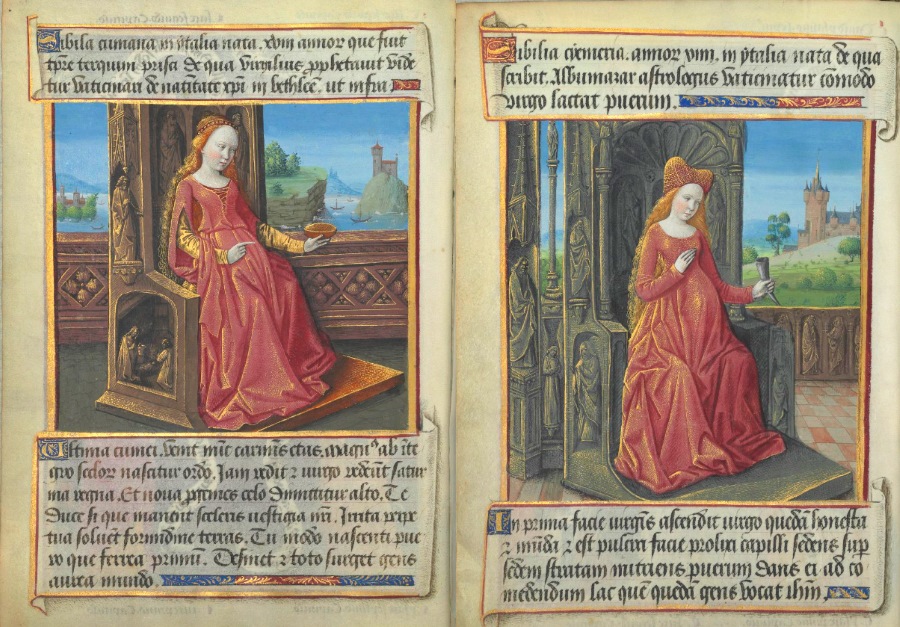

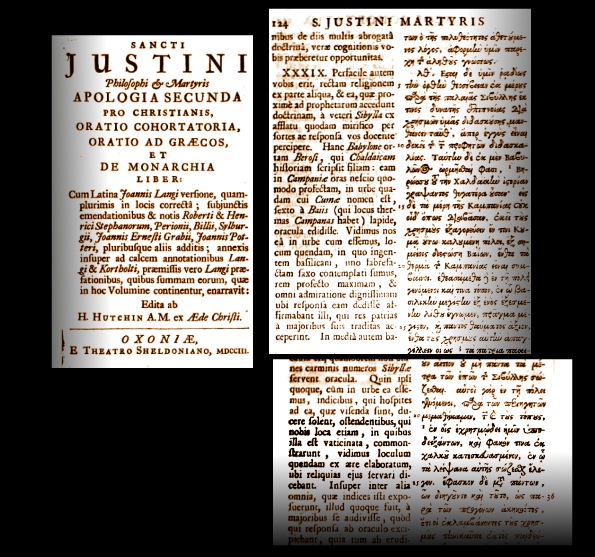

3 Jul 2018
A Sibyl called Cimmerian: exploring the potential link to the Apennine Sibyl - 8. Cumae, a land of netherworld gods
After a close scrutiny of a number of ancient literary sources, we found out that the Cimmerian Sibyl belongs to the area of the Lake Avernus, in the Italian region of Campania: only a mile away from the traditional site where the Cumaean Sibyl is said to have rendered her oracular responses by the ancient town of Cumae.
This result - which is already well known by scholars - should not be considered as unexpected. When we started our investigation, we noted, as many scholars did in the past, that in the classical enumeration of ten oracles set down by Lactantius the seventh Sibyl was the Cumaean («Cumana» in Latin), and the fourth the Cimmerian; however, in some versions of Lactantius' “De Divinis Institutionibus” the fourth oracle appears with the attribute “Cumean”: a name that cannot but remind us of the antique town of Cumae, and an attribute providing a strong clue as to where to direct our research efforts.
And finally we caught the Cimmerian Sibyl in very region of Cumae. But why should there be two different Sibyls in the same area, a Cumaen and a Cimmerian?
First, we have to bear in mind the utterly peculiar nature of this portion of Italian land.
Let's fly over this corner of Campania, in southern Italy, by considering the attached map: we are hovering on a territory which is heavily, permanently marked by the mightiest subterranean powers in Europe. A land blessed - and doomed - by the Gods of the Netherworld.
Eastward of Cumae and Cape Misenus, since time immemorial, the ground has been ravaged by the fury of volcanoes. We are in the most renowned Phlegraean Fields, a large volcanic area hiding one of the most dangerous, and still active today, subterranean magmatic chambers in the world.
The Lake Avernus itself, at the center of the image, is a volcanic crater lake, once encircled by gloomy hills covered with mysterious woods. Strabo says that «the birds that cross the lake fall down into the waters, being killed by the vapours that rise from it, as it happens for places which are linked to the Netherworld» («aves quae supervolarent in aquam decidere, exanimatas aeris exhalatione, quemadmodum i Plutonijs locis fit» in Latin). A number of additional volcanic calderas (Mount Barbaro, the large Astroni crater, and many others) are present in the top side of the picture, including the small yet impressive Monte Nuovo ('The New Mountain'), a tiny volcano which was created from nothing by a sudden eruption which took place between September, 29 and October, 6 1538. Earthquakes, emission of volcanic gases and measurable displacements of the ground (a phenomenon known as 'bradyseism') have always happened there.
No wonder that this land has always been considered as sacred to subterranean, divine powers. In Book 6 of his “Aeneid”, Publius Vergilius Maro sends Aeneas to the shore of Cumae, in search of the entryway to the underworld, «protected by the gloomy lake and the darkness of the woods» («tuta lacu nigro nemorumque tenebris» in Latin). And, according to many scholars, Lake Avernus was actually seen by ancient Romans as the entrance to Hades.
In this highly evocative context were rooted two different sibilline tradition: the Cumaean oracle and the Cimmerian oracle. However, both traditions, though documented through many literary passages drawn from a number of Latin and Greek authors, are not so easy to pinpoint from a storical and archeological points of view, as we will see in the next article.
Una Sibilla chiamata Cimmeria: un'investigazione sulla possibile relazione con la Sibilla Appenninica - 8. Cuma, terra di dèi inferi
Dopo avere attentamente esaminato una pluralità di fonti letterarie antiche, abbiamo scoperto come la Sibilla Cimmeria sia appartenuta all'area del Lago di Averno, situata nella regione chiamata Campania: ad un solo miglio di distanza dal sito tradizionale presso il quale si ritiene che la Sibilla Cumana rendesse i propri responsi oracolari, nell'antica città di Cuma.
Questo risultato - già ben noto agli studiosi - non dovrebbe essere considerato come del tutto inatteso. Quando abbiamo dato inizio alla nostra investigazione, abbiamo potuto osservare, come già notato in passato da molti ricercatori, come nella classica enumerazione redatta da Lattanzio e concernente dieci oracoli la settima Sibilla fosse la Cumana, e la quarta la Cimmeria; eppure, in alcune versioni del "De Divinis Institutionibus" di Lattanzio, la quarta Sibilla appare con l'attributo di "Cumaea": un appellativo che non può non riportare alla nostra mente l'antico nome di Cuma, fornendoci così un potente indizio utile ad identificare verso quale direzione volgere la nostra ricerca.
E, finalmente, siamo riusciti a rintracciare la Sibilla Cimmeria esattamente nell'area di Cuma. Ma come è possibile che vi fossero due differenti Sibille nella medesima area, una Cumana e una Cimmeria?
Come prima cosa, dobbiamo fissare bene in mente quale sia la peculiarissima natura di questa porzione della terra d'Italia.
Proviamo a volare insieme su questo angolo di Campania, nell'Italia meridionale, prendendo in considerazione la mappa qui allegata: stiamo sorvolando un territorio che è pesantemente e permanentemente marcato dalle più maestose potenze sotterranee dell'intera Europa. Una terra benedetta - e maledetta - dagli Dèi Inferi.
Ad est di Cuma e Capo Miseno, sin da tempo immemorabile, la terra è stata devastata dalla furia dei vulcani. Ci troviamo nei celeberrimi Campi Flegrei, una vasta regione vulcanica che nasconde una delle più pericolose, e del tutto attive ai nostri giorni, camere magmatiche sotterranee dell'intero globo.
Lo stesso Lago di Averno, al centro dell'immagine, è un lago formatosi all'interno di un cratere vulcanico, un tempo circondato da tenebrose colline ricoperte da boschi spaventevoli. Strabone racconta di come «gli uccelli che lo sorvolavano piombassero nell'acqua, uccisi dalle esalazioni di quei vapori, così come accade nei luoghi consacrati a Plutone» («aves quae supervolarent in aquam decidere, exanimatas aeris exhalatione, quemadmodum i Plutonijs locis fit» in Latino). E ulteriori, numerose caldere vulcaniche (Monte Barbaro, il grande cratere degli Astroni, e molti altri) sono inoltre presenti nella porzione superiore dell'immagine, compreso il piccolo ma impressionante Monte Nuovo, un minuscolo vulcano formatosi dal nulla in conseguenza di un'improvvisa eruzione che ebbe luogo tra il 29 settembre e il 6 ottobre 1538. Terremoti, emissione di gas vulcanici e sensibili spostamenti verticali del terreno (un fenomeno denominato 'bradisismo') hanno avuto luogo in questa zona da sempre.
Non c'è dunque da meravigliarsi se questa terra sia stata da sempre considerata come sacra alle divine potenze del sottosuolo. Nel Libro 6 dell'"Eneide", Publio Virgilio Marone invia Enea fino alle spiagge di Cuma, in cerca dell'ingresso al mondo sotterraneo dei morti, «guardato dal nero lago e dall'oscurità delle selve» («tuta lacu nigro nemorumque tenebris» in Latino). E, secondo molti studiosi, il Lago Averno era effettivamente considerato dagli antichi Romani come il punto di ingresso all'Ade.
In questo contesto così altamente evocativo hanno avuto modo di radicarsi ben due differenti tradizioni sibilline: l'oracolo Cumano e quello Cimmerio. Eppure, nessuna delle due tradizioni - benché entrambe risultino essere menzionate in vari brani letterari tratti da diversi autori sia greci che latini - sembra essere facilmente documentabile dal punto di vista storico e archeologico, come avremo modo di vedere nel prossimo articolo.
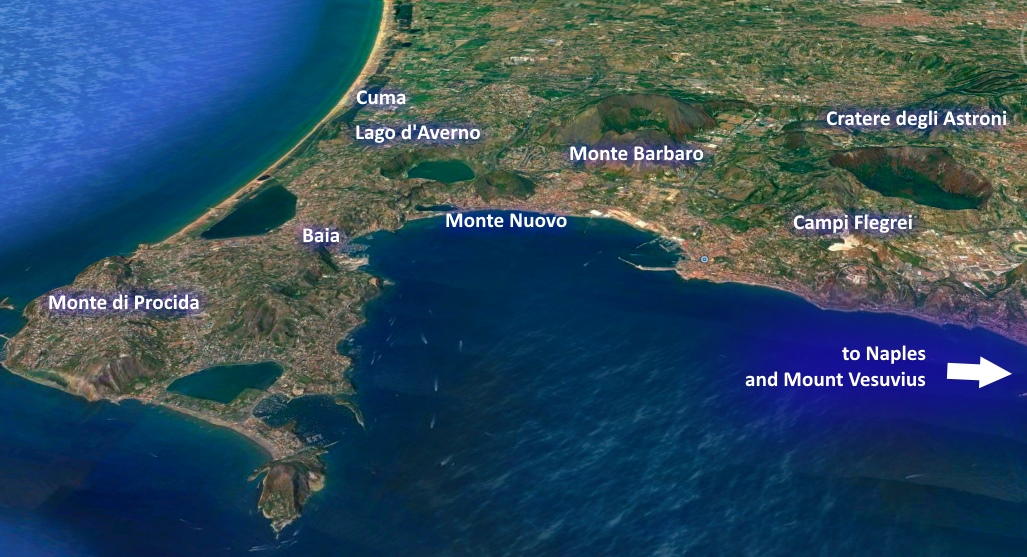

1 Jul 2018
A Sibyl called Cimmerian: exploring the potential link to the Apennine Sibyl - 7. A subterranean Sibyl at the Lake Avernus
By following the footprints left by the Cimmerian Sibyl throughout the centuries, we have come back to the classical age, when southern Italy was the magical scenario for colonies established by settlers moving from Greece.
In the seaside region set between Cumae, Mount Procida with Cape Misenus, Baiae and Pozzuoli, lay an area which was the realm of mighty subterranean powers: a volcanic area, fully active at that times as it is today, and where the gloomy Lake Avernus stood (see Fig. 1), surrounded by looming hills and protected by an impenetrable forest. There, an antique population had their abode, the Cimmerians, who lived in subterranean dwellings.
And they served an oracle, hidden from view and set under the ground. An oracle which vaticinated by querying the dead, as Strabo recounts in his “Geographica”:
«Those who lived prior to our age applied to Lake Avernus the fairy tale about necromancy which is found in Homer, and so much so that they thought here was the oracle where the dead uttered prophecies as if they were alive: the oracle to which Ulysses came».
[In the Latin translation from the original Greek text: «Qui nos aetate antecesserunt, Necyae Homericae fabulas Averno applicaverunt, atque adeo narrant fuisse ibi oraculum ubi vita defuncti responsa darent, eoque Ulissem advenisse»].
But who provided a bridge between the world of the dead and the living men who asked for responses?
It was a Sibyl.
Let's read from a remarkable excerpt taken from “Origo Gentis Romanae” (“The Origin of Roman People”), a fourth-century work attributed to Latin author Sextus Aurelius Victor. The passage depicts Aeneas after his arrival to Italy following the destruction of Troy:
«Aeneas buried on the shore the mother of Euxinus, one of his comrades, who had been carried off by old age, around the marsh which is between Misenus and Avernus, and that, thence, the name was assigned to the spot. And when he had discovered that in that very place a Sibyl chanted future events to mortals in the city which is called Cimbarionis, [they add that] he came to it, having inquired about the state of his own fortunes, and having been forbidden to bury in Italy his relative Prochyta, related to him by blood, whom he had left in good health. And afterwards he returned to the fleet and found she was dead in actual truth...».
[In the original Latin text: «Aeneam in eo litore Euxini cuiusdam comitis matrem ultime aetatis affectam circa stagnum, quod est inter Misenon Avernumque, extulisse atque inde loco nomen inditum; cumque comperisset ibidem Sibyllani mortalibus futura praecinere in oppido, quod vocatur Cimbarionis, venisse eo sciscitatum de statu fortunarum suarum aditisque fatis vetitum, ne is cognatam in Italia sepeliret Prochytam, cognatione sibi coniunctam, quam incolumem reliquerat. Et postquam ad classem rediit repperitque mortuam...»].
In the town of Cimmerians («Cimbarionis» in Strabo), hidden beneath the ground and set between Cape Misenus and the Lake of Alvernus, there was a Sibyl, who vaticinated through the responses given by the dead.
At last, we have found the Cimmerian Sibyl: she was another Italian Sibyl, included in the classical list set down by Lucius Caecilius Firmianus Lactantius, also including two other Sibyls from Italy, namely the Cumaean and the Tiburtine. And her abode was under the hills of Lake Avernus, not far from Cumae and Naples.
But what about the Cumaean Sibyl, whose shrine was also present in the very same area? And what about the alleged relationship - as stated by Francesco Maurolico in the sixteenth century - between the Cimmerian and the Apennine Sibyl, who was set in an utterly different region of Italy? Now, it seems to us that the pieces of the jigsaw puzzle are all coming together, and they indicate that no relation can be highlighted between the two Sibyls.
We will try to disentagle the above remaining questions in the next article.
Una Sibilla chiamata Cimmeria: un'investigazione sulla possibile relazione con la Sibilla Appenninica - 7. Una Sibilla nel sottosuolo presso il Lago d'Averno
Seguendo le orme lasciate dalla Sibilla Cimmeria nel corso dei secoli, siamo tornati indietro nel tempo sino all'età classica, quando l'Italia meridionale era un territorio dai magici scenari per i molteplici insediamenti ivi stabiliti dai coloni provenienti dalla Grecia.
Nella zona costiera posta tra Cuma, il Monte Procida e il Capo Miseno, Baia e Pozzuoli, si trovava una regione che era il regno misterioso abitato da immani potenze sotterranee: un'area vulcanica, viva e attiva oggi come allora, dove si trovava il tenebroso Lago d'Averno (Fig. 1), circondato da incombenti colline e protetto da una foresta impenetrabile. Proprio lì aveva la propria dimora un popolo antico, i Cimmèri, i quali vivevano nel sottosuolo.
E questo popolo serviva un oracolo, nascosto alla vista e posto nel sottosuolo. Un oracolo che vaticinava interrogando i morti, così come ci racconta Strabone nella sua opera “Geographica”:
«Coloro che vissero prima di noi, considerarono il Lago d'Averno come il luogo in cui si svolge il leggendario episodio della negromanzia raccontato da Omero, tanto da narrare come si trovasse proprio lì l'oracolo che otteneva responsi dai morti come se essi fossero vivi: lo stesso oracolo al quale si rivolse Ulisse».
[Nella traduzione latina dall'originale Greco: «Qui nos aetate antecesserunt, Necyae Homericae fabulas Averno applicaverunt, atque adeo narrant fuisse ibi oraculum ubi vita defuncti responsa darent, eoque Ulissem advenisse»].
Ma chi era a stabilire la comunicazione tra il mondo dei morti e quello dei vivi, uomini mortali in cerca di oracolari responsi?
Si trattava di una Sibilla.
Andiamo infatti a leggere un significativo passaggio tratto dall'“Origo Gentis Romanae”, un'opera del quarto secolo attribuita all'autore latino Sesto Aurelio Vittore. Il brano racconta di Enea, l'eroe troiano appena giunto in Italia dopo la distruzione della sua città e della sua gente:
«Enea seppellì su quella spiaggia la madre di Eusino, uno dei suoi compagni, deceduta a causa dell'età avanzata; la seppellì vicino alla palude che si trova tra Miseno e l'Averno, ed ecco da dove quel luogo trasse il proprio nome. E quando venne a sapere che nel villaggio, chiamato Cimbarione, una Sibilla cantava ai mortali il futuro, egli vi si recò e, avendo chiesto un responso a proposito del suo stesso destino, ed essendogli stato proibito di seppellire in Italia la sua congiunta Prochyta, a lui consanguinea, che egli aveva lasciato in buona salute, si affrettò a tornare presso la flotta, e trovò che veramente ella era morta...».
[Nel testo originale latino: «Aeneam in eo litore Euxini cuiusdam comitis matrem ultime aetatis affectam circa stagnum, quod est inter Misenon Avernumque, extulisse atque inde loco nomen inditum; cumque comperisset ibidem Sibyllani mortalibus futura praecinere in oppido, quod vocatur Cimbarionis, venisse eo sciscitatum de statu fortunarum suarum aditisque fatis vetitum, ne is cognatam in Italia sepeliret Prochytam, cognatione sibi coniunctam, quam incolumem reliquerat. Et postquam ad classem rediit repperitque mortuam...»].
Nella città dei Cimmèri («Cimbarionis» in Strabone), nascosta nel sottosuolo e posta tra Capo Miseno e il Lago d'Averno, operava una Sibilla, che profetava per mezzo di responsi ottenuti interrogando le anime dei morti.
Siamo riusciti dunque, finalmente, ad arrivare fino alla Sibilla Cimmeria: essa era un'ulteriore Sibilla italica, inclusa nell'elencazione classica definita da Lucio Cecilio Firmiano Lattanzio, che comprendeva anche due ulteriori Sibille originarie dell'Italia, la Cumana e la Tiburtina. E la sua dimora si trovava al di sotto delle colline che circondavano il Lago d'Averno, non lontano da Cuma e Napoli.
E la Sibilla Cumana? Cosa possiamo dire a proposito di questa Sibilla, il cui tempio oracolare era anch'esso presente proprio nella medesima area? E cosa possiamo ora affermare in merito alla supposta connessione - così come rivendicata da Francesco Maurolico nel sedicesimo secolo - tra la Sibilla Cimmeria e quella Appenninica, la cui dimora si trova invece in una regione d'Italia totalmente differente? Sembrerebbe proprio, adesso, che tutti i pezzi del rompicapo comincino ad incastrarsi tra loro, e ciò i vari elementi reperiti cominciano ad indicare non pare che vadano a stabilire alcuna relazione tra le due Sibille.
Proveremo a rispondere a queste intricate questioni nel prossimo articolo.
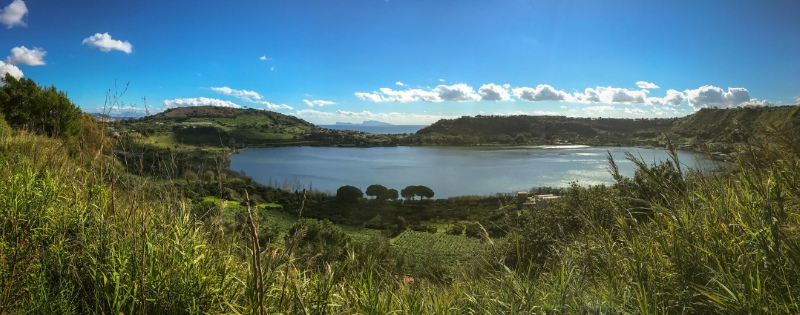

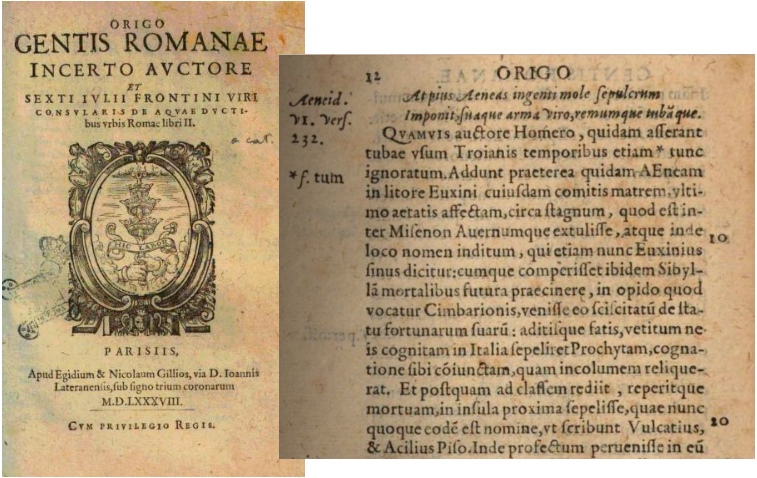

29 Jun 2018
A Sibyl called Cimmerian: exploring the potential link to the Apennine Sibyl - 6. The Cimmerians and their oracle
We are still on the footsteps of the Cimmerian Sibyl, the fourth oracle mentioned in the classical enumeration provided by Lucius Caecilius Firmianus Lactantius in the fourth century. A Sibyl that in some versions of Lactantius “De Divinis Institutionibus” is presented as “Cumean”, a word that brings to the mind of the reader the word 'Cumae', the Campanian town of the Cumaean Sibyl, who in turn is listed under number seven in Lactantius' list.
So the main question now is: where is the Cimmerian Sibyl from? According to Francesco Maurolico, a sixteenth-century Sicilian author, she would reside by a town called «Ameria» or a village named «Cimerio» lying by the caves of Norcia, so the Cimmerian Sibyl and the Apennine Sibyl would actually be the very same oracle.
But only Maurolico (and a Father Fortunato Ciucci from Norcia, who quotes from Maurolico in the seventeenth century) supports this assumption.
No other similar identification is retrieved in other authors or works, either in the main sources used by Maurolico (the “Mappemonde Spirituelle” by Jean Germain, which we saw in a previous paper) or the “Oracula Sibyllina” and Filippo Barbieri's “Opuscula”.
So, if we want to find the truth, we have no choice left: we have to turn back and return to classical authors.
The key to all that is the nature and identity of the people known as 'Cimmerians'. Today, many people think that Cimmerians were an ancient tribal population who lived in the Caucasus. In fact they are mentioned by the Greek historian Herodotus, and have become part of a wider, contemporary popular culture through the fictional tales of Conan the Cimmerian, written by American author Robert E. Howard, in which Cimmerians are depicted as an offspring of a Celtic, northern-European culture.
But this is only a minor tradition, though the most widely known, concerning the Cimmerians.
Because if we look for Cimmerians in classical literature, we find no Celts and no Caucasus at all: instead, we are transported back to a place we already know. We know it well, owing to a most famous Sibyl.
And this place is Cumae.
Because, if the works by ancient writers such as Gnaeus Naevius and Lucius Calpurnius Piso Frugi - who mentioned the Cimmerian Sibyl as Lactantius indicates- are unfortunately lost to us, nonetheless there are still other ancient authors whose works survive. And they all tell unanimously the same story: Cimmerians lived in southern Italy, namely near Cumae (Fig. 1 - Ancient Cumae in a map detail taken from the Tabula Peutingeriana, a thirteenth-century copy on parchment of an original Roman road map - Österreichische Nationalbibliothek, Codex Vindobonensis 324).
Let's listen to the ancient voices which narrate this amazing tale. And we are about to start with the war cry sent out long ago by Hannibal, the great Carthaginian general:
«Soldiers [...] I implore you to make yourselves once more worthy of the reputation you trail after you; and remember the battle of Cannae!»
[In the original Latin text: «Miles [...] obtestor, dignos iam vosmet reddite vestra quam trahitis fama et revocate in pectore Cannas»].
Such are the words reported to us by Silius Italicus, a Roman consul and poet, who wrote his “Punica” at the end of the first century. In his work, Silius describes the anguish and sense of powerlessness that seized Hannibal's heart after the victorious battle of Cannae, followed by a long, idle stay of his army in the Campanian town of Capua. Hannibal fails in capitalizing on his winning moves against the Romans, as his soldiers lose their strength amid banquets and pleasures.
In this occurrence, Hannibal is led by local aristocrats into a visit of the surrounding region, which contains many wonders and notable places, most of them connected to the volcanic nature of the area. The Carthaginian general is shown Baiae, a fashionable resort lying by the Tyrrhenian sea, and the Lake Lucrinus, also known under the name of 'Cocytus' (just like the river flowing in the Otherworld of ancient Greece), and then Lake Avernus, or 'Styx' (another Greek river of the underworld), and the nearby swamps, loaded with dark legends connected to the realm of deads.
Finally, Hannibal listens to the following words (“Punica”, Chapter XII, v. 130-133, as they appear in an antique 1483 edition printed in Venice):
«Close at hand, wrapped in gloom and sunk for long ages in subterranean mists, the city of the Cimmerians lay deep in earth under a pall of shade; and tales are told about the unfathomed night of that Tartarean city».
[In the original Latin text: «Ac iuxta caligante situ longumque per aevum infernis pressas nebulis pallente sub umbra Cymmerias iacuisse domos noctemque profundam Tartareae narrant urbis»].
The subterranean houses of the Cimmerians. A place of mystery and darkness, which lay in the vicinity of Lake Lucrinus, Lake Avernus, and Baiae.
That is, near Cumae.
The Cimmerians are no Celts. In antiquity, it was in the region of Cumae that was located the Cimmerian town, a place of gloominess and absence of light. Here is how Sextus Pompeius Festus - a second-century writer who wrote a “De Verborum Significatione” (“On the meaning of words”), subsequently integrated by the benedictine monk Paul the Deacon - portrays the mysterious Cimmerians (Fig. 3 - Bibliothèque Nationale de France, Latin 7662):
«The Cimmerians are a population inhabiting lands which are subject to the cold of death, and lie between Baiae and Cumae, in the region where a low, large valley is encircled by a huge ridge; the place is never reached by the sun, neither in the morning nor in the evening».
[In the original Latin text: «Cimeri dicuntur homines, qui frigoribus occupatas terras incolunt, quales fuerunt inter Baias et Cumas in ea regione, in qua convallis satis eminenti iugo circumdata est, quae neque matutino, neque vespertino tempore sole contingitur»].
There is no surviving doubt: Herodotus' Cimmerians might have actually lived in the Caucasus, but they are different 'Cimmerians'. There existed, in ancient Italy, an Italic population that was based in the Campania province, in a region where the land itself was enshrouded in magic, which originated from the volcanic nature of the soil. And many authors report about them.
Pliny the Elder, in his first-century “Naturalis Historia”, says in Book III (Fig. 4) that «on the coast [we find] Cumae, a Chalcidian colony, Misenum, the port of Baiae, Bacoli, Lake Lucrinus and Lake Avernus, which is near to where once stood the Cimmerian town. We then come to Puteoli, formerly called the colony of Dicaearchia, then the Phlegraean Plains, and the Marsh of Acherusia in the vicinity of Cumae [...] and then Erculaneum, Pompeii...».
[In the original Latin text: «in ora [...] cumae chalcidesium, misenum, portus baianus, bauli, lacus lucrinus et avernus cimmerium iuxta quem oppidum quondam; deinde puteoli colonia dicerachea dicti, postquem phlegei campi. Acherusia palus Cumis vicina [...] herculaneum, pompeii...»].
And in the third century, Lycophrone of Chalcis, in his poem “Alexandra” (v. 695 - Fig. 5), will write of Odysseus, who «pushes himself beyond the burial place of his helmsman Baius [modern Baiae] and the abode of Cimmerians and the Acherusian plain...», again locating the Cimmerians in the surroundings of Cumae.
But it is Strabo, the Greek geographer and historian, who provides a most comprehensive reference about the Cimmerians in his most renowned “Geographica”, a work written in the first century. In Book V, he describes Cumae, Cape Miseno, the swamps called 'Acherontia' (another name for a river flowing in the Otherworld of ancient Greece), Baiae, the Lake Lucrinus, and the shadowy, blood-curdling Lake Avernus (Fig. 6):
«Avernus, entirely encircled by ridges above, looming on it from every side but a single point; it is now cultivated, however in old times it was enshrouded by an inaccessible wood made of huge trees, which covered with gloomy, superstitious shade the whole lake».
[In a 1571 Latin translation of the original text in Greek: «Avernus superciliis recta sursum enatis et undique praterquam in aditu imminentibus, ac nunc quidem cultura elaboratis; olim enim sylva inaccessa magnarum arborum obsita, ob superstitionem ipsum sinum obumbrabant»].
There, according to Strabo, was the abode of Cimmerians, and their oracle:
«People considered Avernum as a place sacred to Pluto, and that Cimmerians lived there [...] Ephorus maintained that this site was of the Cimmerians, about whom he says that they dwell in underground premises, which they call 'clay-made'; and they come to and fro through subterranean tunnels, and by the same way they allow visitors to the oracle which is deeply dug into the ground; they live on the metal ore they mine, and on those who consult the oracle. [...] And in addition to that, there is an ancient custom that those who live by the oracle must never see the sun, as they can only go outside through the crevices in the ground when the night comes».
[In the Latin translation: «Nam et Avernum p loco Plutoni dicato deputabat, et Cimmerios ibi fuisse indicatu habitare [...] Ephorus vero Cimmeriis locum illum dicans, hos abitare ait in subterraneis aedificiis, quas argillas vocent, ac per fossas quasdam inter se comeare, hospitesque eadem via in oraculum adducere alte infra terram conditum, victum eos metallis effodiendis quarere, et ab ii accipere qui oraculum consulunt [...]. Porro qui apud oraculum illud degunt, eos more a maioribus accepto nunquam videre solem sed noctu ex hiatibus terrae prodire»].
We are getting closer and closer to the true origin of the Cimmerian Sibyl. We have come to Cumae and by the shore of Lake Avernus, in the Italian region of Campania. And we know that the mysterious, almost mythical Cimmerians lived in underground dwellings, and controlled an oracle, deeply set in a subterranean shrine.
Was that oracle a Sibyl?
Yes it was. It was a Cimmerian Sibyl. As we will discover in the next article.
Una Sibilla chiamata Cimmeria: un'investigazione sulla possibile relazione con la Sibilla Appenninica - 6. L'oracolo dei Cimmeri
Ci troviamo ancora sulle tracce della Sibilla Cimmeria, il quarto oracolo menzionato nella classica lista delineata da Lucio Cecilio Firmiano Lattanzio nel quarto secolo. Una Sibilla che, in alcune versioni delle "De Divinis Institutionibus" di Lattanzio viene indicata come "Cumea", un appellativo che riporta alla mente del lettore la parola 'Cuma', la città della Campania nella quale profetava la Sibilla Cumana, la quale, a propria volta, è presente nella lista di Lattanzio con il numero sette.
Ma dove si troverebbe la Sibilla Cimmeria? Secondo Francesco Maurolico, autore siciliano del sedicesimo secolo, essa sarebbe originaria di una città chiamata «Ameria», oppure di un villaggio il cui nome è «Cimerio», situato in prossimità delle grotte di Norcia, in modo tale da far corrispondere la Sibilla Cimmeria con la Sibilla Appenninica, che dunque non sarebbero altro che il medesimo oracolo.
Eppure, a sostenere questa identità è solamente Maurolico (e Padre Fortunato Ciucci da Norcia, che nel diciassettesimo secolo, citerà brani tratti da Maurolico).
Nessun altro autore od opera riferisce di una simile identificazione, né le fonti primarie di Maurolico (il "Mappemonde Spirituelle" di Jean Germain, che abbiamo avuto occasione di considerare in un precedente articolo), né altre fonti quali gli "Oracula Sibyllina" o gli "Opuscula" di Filippo Barbieri.
Se vogliamo arrivare alla verità, non abbiamo allora altra scelta: dobbiamo volgerci verso il passato e tornare agli autori della classicità.
La chiave di tutto questo problema si trova nella vera natura e identità del popolo conosciuto con il nome di 'Cimmèri'. Oggi, molti sono convinti che i Cimmèri siano stati un'antica popolazione tribale vissuta nella regione del Caucaso. In effetti, il loro nome è mezionato dallo storico greco Erodoto, ed essi sono inoltre divenuti parte di una più diffusa cultura popolare contemporanea grazie ai racconti fantasy di Conan il Cimmero, ideati dal narratore americano Robert E. Howard, in cui i Cimmèri sono rappresentati come appartenenti ad una cultura di origine celtica e nordeuropea.
Ma si tratta solamente di una tradizione secondaria, benché certamente la più nota tra il grande pubblico, riguardante il popolo dei Cimmeri.
Perché se andiamo a ricercare i Cimmèri nella letteratura della classicità, non troviamo né Celti né tantomeno il Caucaso: ci troviamo, invece, ad essere riportati verso un luogo che già conosciamo. E lo conosciamo bene, grazie ad una famosa, notissima Sibilla.
E questo luogo è Cuma.
Perché, se è vero che le opere di antichi autori quali Gneo Nevio e Lucio Calpurnio Pisone Frugi - che parlarono della Sibilla Cimmeria, come ci racconta Lattanzio - sono andate sfortunatamente perdute, nondimeno esistono altri e diversi autori i cui testi sono giunti fino a noi. E tutti loro, tutti insieme, ci raccontano la stessa identica storia: i Cimmèri vivevano nell'Italia meridionale, e precisamente in prossimità della città di Cuma (Fig 1 - l'antica Cuma così come appare in un dettaglio tratto dalla Tabula Peutingeriana, copia del tredicesimo secolo su pergamena di mappa stradale romana originale - Österreichische Nationalbibliothek, Codex Vindobonensis 324).
Ascoltiamo allora le antiche voci che ci raccontano questa incredibile storia. E cominciamo con il grido di battaglia innalzato secoli fa da Annibale, il grande generale cartaginese:
«Soldati [...] io vi imploro, siate ancora una volta degni della fama che segue il vostro nome, e richiamate nei cuori la gloriosa battaglia di Canne!»
[Nel testo originale latino: «Miles [...] obtestor, dignos iam vosmet reddite vestra quam trahitis fama et revocate in pectore Cannas»].
Sono queste le parole riferiteci da Silio Italico, console e poeta dell'antica Roma, il quale scrisse il suo poema "Punica" alla fine del primo secolo. In quest'opera, Silio descrive l'angoscioso senso di impotenza che si era impossessato dell'animo di Annibale dopo la vittoriosa battaglia di Canne, seguita da una lunga, oziosa permanenza del suo esercito nella città campana di Capua. Annibale non riesce a rendere produttive le vittoriose azioni da lui condotte contro i Romani, mentre i suoi soldati perdono progressivamente la propria bellicosa determinazione tra banchetti e piaceri d'ogni genere.
In questo contesto, Annibale viene accompagnato dai notabili del luogo in una visita della circostante regione, che contiene molte meraviglie e paesaggi rimarchevoli, molti dei quali connessi alla natura vulcanica dell'intera zona. Al generale cartaginese viene mostrata Baia, luogo di villeggiatura alla moda posto sulle rive del Mar Tirreno, e il Lago Lucrino, conosciuto anche con il nome di Cocito (proprio come il fiume che scorre nell'Ade dell'antica Grecia), e poi il Lago d'Averno, detto anche Stige (come un altro dei fiumi appartenenti al mondo greco dell'oltretomba), e infine le vicine paludi, ricolme di tenebrose leggende collegate al mondo dei morti.
È a questo punto che ad Annibale vengono rivolte le seguenti parole (“Punica”, Capitolo XII, v. 130-133, così come appaiono in un'antica edizione a stampa pubblicata a Venezia nel 1483):
«Non lontano da quei luoghi, avvolti nella tenebra e sprofondati per lunghe ere nelle nebbie infere, le dimore dei Cimmèri giacquero nell'ombra livida; e molto si racconta della notte profonda di quella città sotterranea».
[Nel testo originale latino: «Ac iuxta caligante situ longumque per aevum infernis pressas nebulis pallente sub umbra Cymmerias iacuisse domos noctemque profundam Tartareae narrant urbis»].
Le dimore sotterranee dei Cimmèri. Un luogo di mistero e di tenebra, che giace in prossimità del Lago Lucrino, del Lago d'Averno, e di Baia.
E cioè, nelle vicinanze di Cuma.
I Cimmèri non sono Celti. Nell'antichità, era proprio nella regione di Cuma che era situata la città Cimmeria, un luogo di tenebra e assenza di luce. Ecco come Sesto Pompeo Festo - autore del secondo secolo che scrisse un'opera dal titolo "De Verborum Significatione" ("Sul significato delle parole"), in seguito integrata dal monaco benedettino Paolo Diacono - ci presenta i misteriosi Cimmèri (Fig. 3 - Bibliothèque Nationale de France, Latin 7662):
«Cimmèri sono detti quegli uomini che abitano le terre soggette al rigore del freddo, quali furono situate tra Baia e Cuma, in quella regione dove una vasta, profonda valle è circondata da un'alta cresta; lì mai riesce a giungere né il sole del mattino, né quello della sera».
[Nel testo originale latino: «Cimeri dicuntur homines, qui frigoribus occupatas terras incolunt, quales fuerunt inter Baias et Cumas in ea regione, in qua convallis satis eminenti iugo circumdata est, quae neque matutino, neque vespertino tempore sole contingitur»].
Non c'è alcun dubbio. Forse i Cimmèri di Erodoto hanno realmente percorso le steppe del Caucaso, ma si tratta di altri e diversi 'Cimmèri'. Esisteva invece, nell'Italia antica, una popolazione che dimorava nella provincia della Campania, in quella regione dove la terra stessa era avvolta nella magia, che trovava origine nella natura vulcanica del suolo. E molti autori ci raccontano questa storia.
Plinio il Vecchio, nella sua "Naturalis Historia", risalente al primo secolo, afferma nel Libro III (Fig. 4) che «sulla costa [troviamo] Cuma, colonia calcidica, Miseno, il porto di Baia, Bacoli, il Lago Lucrino e quello d'Averno, che si trova vicino al luogo dove un tempo sorgeva la città dei Cimmèri; e poi Pozzuoli, una volta chiamata colonia della Dicaearchia, poi i Campi Flegrei, la palude Acherusia in prossimità di Cuma [...] e inoltre Ercolano, Pompei...».
[Nel testo originale latino: «in ora [...] cumae chalcidesium, misenum, portus baianus, bauli, lacus lucrinus et avernus cimmerium iuxta quem oppidum quondam; deinde puteoli colonia dicerachea dicti, postquem phlegei campi. Acherusia palus Cumis vicina [...] herculaneum, pompeii...»].
E nel terzo secolo, Licofrone di Calcide, nel poema "Alexandra" (v. 695 - Fig. 5), scriverà di Ulisse e di come l'eroe si fosse «spinto oltre il luogo di sepoltura del suo timoniere Baio [la moderna Baia] e la dimora dei Cimmèri e la pianura Acherusia...», nuovamente collocando i Cimmèri nelle immediate vicinanze di Cuma.
Ma è Strabone, lo storico e geografo greco, a fornirci il riferimento più completo a proposito dei Cimmèri all'interno della sua notissima opera "Geographica", risalente al primo secolo. Nel Libro V, Strabone descrive Cuma, Capo Miseno, le paludi chiamate con il nome 'Acherontia' (un altro nome corrispondente a uno dei fiumi che scorre nell'Ade degli antichi Greci), Baia, il Lago Lucrino, e il tenebroso, agghiacciante Lago d'Averno (Fig. 6):
«Averno, completamente circondato in alto da creste, ovunque incombenti su di esso a meno di un solo varco; oggi coltivato, ma un tempo avvolto da un'inaccessibile selva di grandi alberi, che oscuravano quel lago con ombre di superstizione».
[Dalla traduzione latina del testo originale greco pubblicata nel 1571: «Avernus superciliis recta sursum enatis et undique praterquam in aditu imminentibus, ac nunc quidem cultura elaboratis; olim enim sylva inaccessa magnarum arborum obsita, ob superstitionem ipsum sinum obumbrabant»].
E lì, secondo quanto ci racconta Strabone, c'era non solo la dimora dei Cimmèri, ma anche quella del loro oracolo:
«Il Lago d'Averno era considerato come un luogo dedicato a Plutone, e si credeva che lì abitassero i Cimmèri [...] Eforo sosteneva che quel luogo fosse dei Cimmèri; egli affermava che essi dimorassero in luoghi sotterranei, detti 'argille', e che si incontrassero per mezzo di tunnel sotterranei, e che tramite le stesse vie introducessero i visitatori presso il loro oracolo, posto in profondità nella terra; essi si procuravano da vivere scavando i metalli, e grazie a ciò che guadagnavano da coloro che si recavano all'oracolo. [...] Inoltre, secondo un'antica traadizione coloro che servono l'oracolo non possono mai vedere la luce del sole, e solamente di notte essi possono uscire dalle fessure della terra».
[Nella traduzione latina: «Nam et Avernum p loco Plutoni dicato deputabat, et Cimmerios ibi fuisse indicatu habitare [...] Ephorus vero Cimmeriis locum illum dicans, hos abitare ait in subterraneis aedificiis, quas argillas vocent, ac per fossas quasdam inter se comeare, hospitesque eadem via in oraculum adducere alte infra terram conditum, victum eos metallis effodiendis quarere, et ab ii accipere qui oraculum consulunt [...]. Porro qui apud oraculum illud degunt, eos more a maioribus accepto nunquam videre solem sed noctu ex hiatibus terrae prodire»].
Ci stiamo avvicinando sempre di più alla vera origine della Sibilla Cimmeria. Siamo giunti a Cuma e alle rive del Lago d'Averno, nella regione della Campania. E sappiamo, ora, che i misteriosi, leggendari Cimmèri vivevano in dimore sotterranee, e controllavano un oracolo, profondamente sepolto in un tempio ipogeo.
Questo oracolo era una Sibilla?
Sì, lo era. Era una Sibilla dei Cimmèri. Come scopriremo nel prossimo articolo.
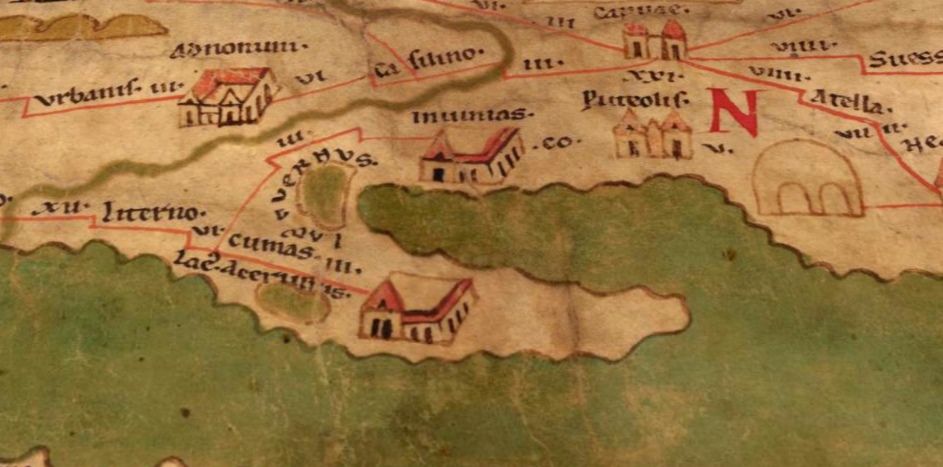

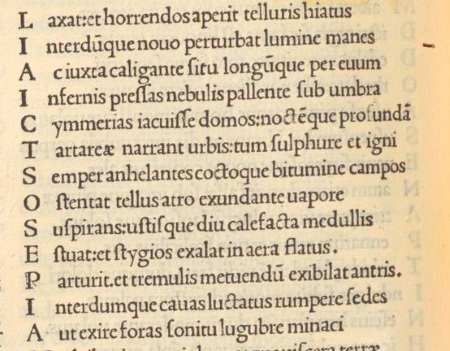

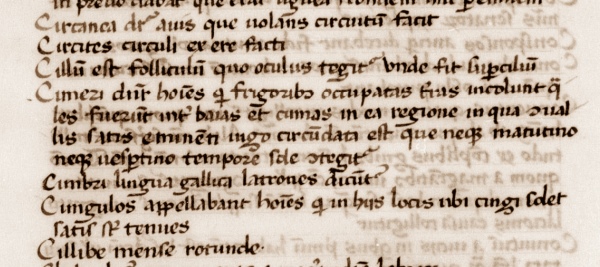

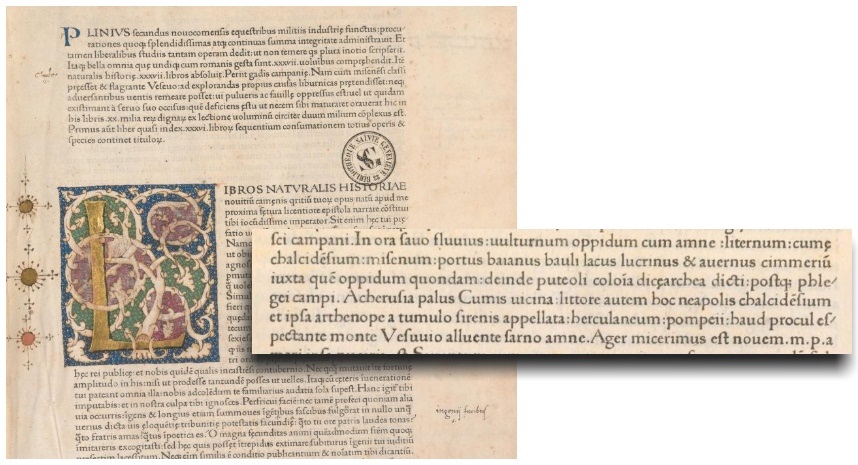

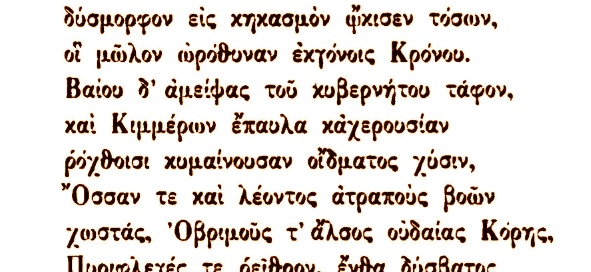

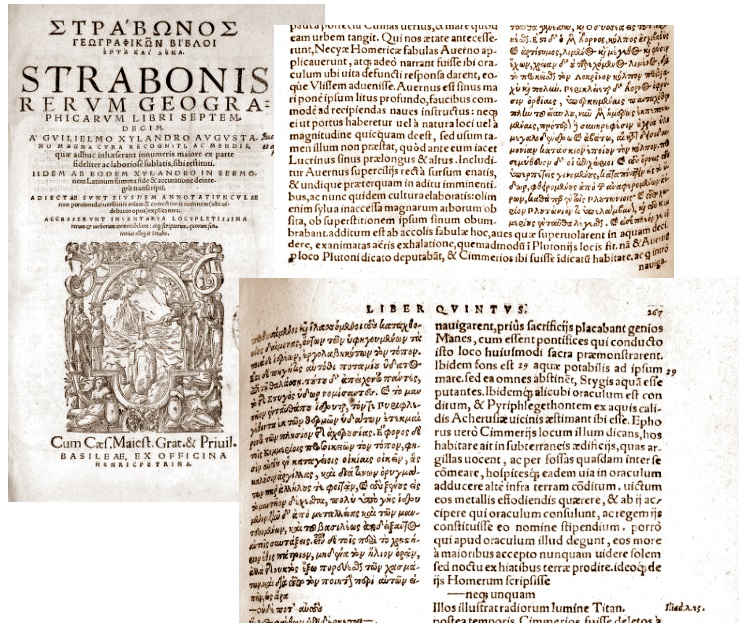

24 Giu 2018
A Sibyl called Cimmerian: exploring the potential link to the Apennine Sibyl - 5. Albumazar and the transformation into a Christian Sibyl
Starting from a series of quotes extracted from Francesco Maurolico's “Topographia Sanctorum Christi Martyrum”, we are trying to understand whether a Sibyl called 'Cimmerian' might have anything to do with the Sibyl of Norcia, established beneath a mountain in the Italian Apennines (see figure 1), as alleged by Maurolico himself.
However, in the course of our search we have stumbled upon a number of unexpected obstacles.
To begin with, the Cimmerian Sibyl, included in the classical list of ten Sibyls set down by Lucius Caecilius Firmianus Lactantius in his “De Divinis Institutionibus”, written in the fourth century, often appears in different editions of this Latin work with the name of «Cumean», an attribute that seems to signify a close relationship with the Sibyl of Cumae, also listed by Lactantius.
An additional problem is that we cannot proceed into an investigation of the classical authors quoted by Lactantius himself as a reference for the Cimmerian Sibyl (i.e. Marcus Varro, Gnaeus Naevius and Lucius Calpurnius Piso Frugi), because the literary works written by the three of them have not survived, save selected excerpts, thoroughly irrelevant to our search.
If we transfer our investigation to more recent centuries, by perusing ancient, utmostly rare books such as the “Oracula Sibyllina”, preserved at the Abbey of St. Gall in Switzerland, and Filippo Barbieri's “Opuscula”, both printed in the fifteenth century and both mentioning our highly enigmatic Cimmerian Sibyl, we find out that she shows up with different, additional names - «Cyemerian», «Chimerian», «Chimica». Furthermore, she begins to appear as a Christian oracle who would have announced the coming of Jesus on earth, by providing a sort of vision concerning a young maiden with long hair, sitting on a throne and feeding a child with her milk: a manifest portrait of Jesus and the Holy Mary. And additional authors are also mentioned: Ennius, a writer from ancient Rome, and a certain «Albumazar the astrologer».
At this point of our search, confusion seems to preside over the whole matter in an undisputed way.
Will we ever be able to unwind this tangled matter? Our motto is: despair not. Let's try to unfold the many leaves which veil the traditional lore about the Cimmerian Sibyl, by taking them out one by one.
As a first step, let's start with getting rid of «Albumazar», the astrologer. We will show that he adds nothing to our investigation on the origin of the Cimmerian Sibyl and her potential connection to the Apennines.
Who is 'Albumazar'? Albumazar is Abu Ma'shar, one of the greatest Muslim astronomers of past ages, who lived in Baghdad in the eight century. He wrote a number of renowned astrological works, including an “Introductorium maius in astronomiam”, which was widely known in Europe starting from the twelfth century.
In 1133, Johannes Hispalensis translated the work by Albumazar into Latin. And in manuscript Lat 14704, preserved at the Bibliothèque Nationale de France and containing Johannes Hispalensis' translation work, we stumble upon the very origin of the Christian-oriented words that were later attributed to the Cimmerian Sibyl (see figure 2):
«Virgin [the sign of the zodiac] [...] In its first decan [a partition of the sign itself] [...] a maiden will rise, a handsome and honest and pure virgin, with long hair and handsome face, bearing two spikes in her hand; and she sits in a throne and feeds a child giving nourishment to him [...] and the child is called among the nations Jesus...».
[In the original Latin text: «Virgo [...] ascendit in prima facie illius puella [...] et est virgo pulcra atque honesta et munda, prolixi capilli et pulcra facie, habens in manu sua duas spicas; et ipsa sedet super sedem stratam et nutrit puerum, dans ei ad commendendum ius [...], et vocant ipsum puerum quedam gens Ihesum...»].
In the excerpt from Albumazar, an astrological sign conveys a vision of things to come, namely the birth of Jesus, a child attended by a pure virgin, the Holy Mary. In the text by Albumazar, no reference to any Sibyl is present at all.
But the chance was too appealing for later Christian scholars: the oracular tale provided by the heathen Albumazar was unbelievably perfect to illustrate the great plan of God concerning the Incarnation. The tender, emotional prophecy on the Holy Mary feeding Jesus, originally presented in connection to the zodiacal sign of Virgin, was perfectly adaptable to a different witness to God's divine scheme: a virginal Sibyl, announcing the new Christian era, as already alleged centuries earlier by Augustine of Hippo.
So Albumazar's tale was adapted to fit one of the Sibyls included in the list by Lactantius, namely the Cimmerian. To the purpose, in St. Gall's “Oracula Sibyllina”, which we saw in the previous paragraph, the Cimmerian Sibyl is portrayed with a sign where the very same words used by Albumazar are found («In prima facie virginis ascendit virgo quedam honesta et munda et est pulchra facie prolixi capilli...»). And the same we find in Filippo Barbieri's “Opuscula” («... sedens super sedem stratam, nutrit puerum, dans ei ad comedendum ius proprium, idest lac de celo missum»).
And in another translation of Albumazar's “Introductorium in astronomiam”, published in Venice in 1506, the excerpt on the zodiacal sign of Virgo is accompanied by an image of a virgin, with long hair and spikes in her hand, which is almost indistinguishable by a typical pictorial illustration of a Sibyl (see figure 3).
Here we are: the transformation of the Cimmerian / Cumean Sibyl extracted from Lactantius is now completed. By virtue of an evocative text written by an ancient Muslim astrologer, widely known in Europe owing to existing translations of his works into Latin, we now have a Sibyl that acts as a herald on behalf of God, providing an incontrovertible announcement of the future coming of the Salvation.
That's why Albumazar's oracular tale became, in the twelfth and thirteenth centuries, a most favourite topic for Christian preachers willing to convince audiences that the birth of Jesus had been foretold in advance by pagan seers, as noted by some scholars (Marie-Thérèse d'Alverny, 1984). And in subsequent centuries the Cimmerian Sibyl will continue her journey through history properly supplemented with her prophecy, which was usually inscribed in a scroll, as in a fine sixteenth-century frescoed medallion painted on a wall of the “Room of the Sibyls” at the Casa Cavassa City Museum in Saluzzo (a small town near Turin, Italy) (see figure 4).
As a result, the Cimmerian Sibyl has now fully joined the Christian army. However, Albumazar, the Holy Virgin, the child and all the Christian apparatus we have seen above have not helped us in getting one single step closer to the true origin of the Cimmerian Sibyl. That was only a misleading path.
To reach the core of the legend about the Cimmerian Sibyl, we must leave the Christian centuries behind and go back again to classical time.
There, at last, we will find the answers we have been long looking for.
Una Sibilla chiamata Cimmeria: un'investigazione sulla possibile relazione con la Sibilla Appenninica - 5. Albumazar e la trasformazione in Sibilla cristiana
Prendendo le mosse da una collezione di brani tratti dalla “Topographia Sanctorum Christi Martyrum” di Francesco Maurolico, stiamo tentando di verificare se un Sibilla denominata 'Cimmeria' possa avere avuto una relazione di qualche genere con la Sibilla di Norcia, dimorante nel cuore di una montagna facente parte della catena degli Appennini (vedere figura 1), così come sostenuto dallo stesso Maurolico.
Nel corso della nostra ricerca, ci siamo però imbattuti in una serie di ostacoli inattesi.
Innanzitutto, la Sibilla Cimmeria, inclusa nella classica elencazione contenente dieci Sibille delineata da Lucio Cecilio Firmiano Lattanzio nel suo "De Divinis Institutionibus", un'opera latina redatta nel quarto secolo, si presenta nelle diverse versioni oggi disponibili con il nome di «Cumea», un attributo che sembra comportare una stretta connessione con la Sibilla di Cuma, anch'essa elencata dal Lattanzio.
Inoltre, abbiamo evidenziato come non sia oggi possibile procedere ad una indagine di quegli autori classici menzionati da Lattanzio stesso in relazione alla Sibilla Cimmeria (e cioè Marco Varrone, Gneo Nevio e Lucio Calpurnio Pisone Frugi), perché le opere scritte da costoro non sono purtroppo sopravvissute fino ai nostri giorni, a meno di singoli frammenti, del tutto irrilevanti per la nostra ricerca.
Se trasferiamo la nostra indagine verso secoli meno remoti, andando a compulsare libri antichi e rarissimi quali gli "Oracula Sibyllina", conservati presso l'Abbazia di San Gallo in Svizzera, e gli "Opuscula" di Filippo Barbieri, entrambi risalenti al quindicesimo secolo ed entrambi contenenti riferimenti alla nostra enigmatica Sibilla Cimmeria, troviamo che essa si ripropone alla nostra attenzione con nuovi e diversi nomi - «Cyemeria», «Chimeria», «Chimica». E ancora, essa comincia anche ad apparire come un oracolo cristiano, una profetessa che avrebbe preannunciato la venuta del Cristo sulla terra per mezzo di una sorta di visione riguardante una fanciulla dai lunghi capelli, assisa su di un trono e intenta a nutrire un bimbo con il proprio latte: una palese prefigurazione di Gesù e della Vergine Maria. E, addirittura, nuovi autori antichi vengono tirati in ballo: Ennio, scrittore della Roma antica, e un certo «Albumazar l'astrologo».
A questo punto della nostra ricerca, una grande confusione sembra regnare, sovrana e incontrastata, sull'intera materia.
Saremo mai in grado di dipanare il filo di questa intricata matassa? Il nostro motto è: mai disperare. Proviamo a sfogliare assieme i molti veli che oscurano la tradizione leggendaria della Sibilla Cimmeria, provando a diradarli singolarmente ad uno ad uno.
Come primo passo, cominciamo a liberarci di «Albumazar», l'astrologo. Mostreremo come questo autore non aggiunga nulla alla nostra investigazione dedicata all'origine della Sibilla Cimmeria e alla sua possibile relazione con le montagne dell'Appennino.
Chi è 'Albumazar'? Albumazar è Abu Ma'shar, uno dei più grandi astronomi islamici del passato, vissuto a Baghdad nell'ottavo secolo. Fu l'autore di alcune celebri opere astrologiche, tra le quali l'“Introductorium maius in astronomiam”, largamente conosciuto in Europa a partire dal secolo dodicesimo.
Nel 1133, Johannes Hispalensis tradusse l'opera di Albumazar in lingua latina. E proprio all'interno del manoscritto Lat 14704, conservato presso la Bibliothèque Nationale de France e contenente la traduzione redatta da Johannes Hispalensis, veniamo a trovarci di fronte alla fonte originale della profezia di orientamento cristiano che sarà in seguito attribuita alla Sibilla Cimmeria (vedere figura 2):
«Vergine [il segno zodiacale] [...] Nella sua prima decade [una suddivisione del medesimo segno] [...] una fanciulla sorgerà, vergine bellissima e onesta e pura, lunghi i capelli, dal viso armonioso, con due spighe nella mano; ed è assisa su di un trono, intenta a nutrire un fanciullo, sostentandolo con appropriato nutrimento [...] e il fanciullo è chiamato tra le nazioni con il nome di Gesù...».
[Nel testo originale latino: «Virgo [...] ascendit in prima facie illius puella [...] et est virgo pulcra atque honesta et munda, prolixi capilli et pulcra facie, habens in manu sua duas spicas; et ipsa sedet super sedem stratam et nutrit puerum, dans ei ad commendendum ius [...], et vocant ipsum puerum quedam gens Ihesum...»].
Nel brano tratto da Albumazar, un segno zodiacale è portatore di una visione degli eventi futuri, in particolare della nascita di Gesù, un bimbo affidato alle cure di una pura vergine, Maria. Nel testo di Albumazar, inoltre, non è presente il minimo riferimento ad alcuna Sibilla.
Ma per i successivi esegeti di orientamento cristiano l'occasione deve essere apparsa troppo ghiotta: il racconto oracolare proposto dal miscredente Albumazar si presentava come assolutamente perfetto al fine di rendere evidente il grande piano di Dio avente per oggetto l'Incarnazione. La dolce profezia di una Santa Vergine che allatta Gesù, originariamente presentata in relazione al segno zodiacale della Vergine, era perfettamente adattabile ad un'altra e diversa testimone del grandioso progetto divino: una virginale Sibilla, intenta a preannunciare l'inizio della nuova era cristiana, così come già sostenuto molti secoli prima da Agostino di Ippona.
E così il racconto di Albumazar fu modificato per essere abbinato ad una delle Sibille incluse nella lista di Lattanzio, la Cimmeria. A questo scopo, negli "Oracula Sibyllina" di San Gallo, che abbiamo avuto modo di vedere nel precedente articolo, la Sibilla Cimmeria è raffigurata assieme ad un cartello che riporta le stesse identiche parole reperibili in Albumazar («In prima facie virginis ascendit virgo quedam honesta et munda et est pulchra facie prolixi capilli...»). E lo stesso testo troviamo negli "Opuscula" di Filippo Barbieri («... sedens super sedem stratam, nutrit puerum, dans ei ad comedendum ius proprium, idest lac de celo missum»).
E in una diversa traduzione dell'“Introductorium in astronomiam” di Albumazar, pubblicata a Venezia nel 1506, il brano concernente il segno zodiacale della Vergine è accompagnato dall'immagine di una fanciulla dai lunghi capelli, con in mano delle spighe, che pare quasi indistinguibile dalla raffigurazione tipica di una Sibilla (vedere figura 3).
Ed eccoci arrivati: la trasformazione della Sibilla Cimmeria / Cumea tratta da Lattanzio è ora completa. Grazie all'evocativo testo scritto da un antico astronomo islamico, ben conosciuto in Europa attraverso le traduzioni delle sue opere in lingua latina, ci troviamo ad avere una Sibilla che opera in qualità di araldo per conto di Dio, fornendo un annuncio incontrovertibile e veritiero del futuro approssimarsi della Salvezza.
Ecco dunque perché il racconto profetico di Albumazar divenne, nel dodicesimo e tredicesimo secolo, uno dei soggetti favoriti trattati dai predicatori cristiani impegnati a convincere il popolo del fatto che la nascita del Cristo fosse stata preannunciata in anticipo da veggenti pagane, così come segnalato da alcuni studiosi (Marie-Thérèse d'Alverny, 1984). E, nei secoli successivi, la Sibilla Cimmeria continuerà il proprio viaggio attraverso la storia accompagnata dalla profezia a lei riferita, opportunamente trascritta su di un apposito cartiglio, così come appare, ad esempio, in un pregevole medaglione cinquecentesco affrescato su una delle pareti della "Sala delle Sibille" nel Museo Civico Casa Cavassa di Saluzzo (Cuneo) (vedere figura 4).
Il risultato di tutto ciò è stato il pieno arruolamento della Sibilla Cimmeria nell'esercito cristiano. Malgrado ciò, né Albumazar, né la Santa Vergine, né il fanciullo, né tutto l'apparato cristiano che abbiamo appena illustrato ci aiutano ad avvicinarci di un singolo passo alla vera origine del mito della Sibilla Cimmeria. Si tratta, come abbiamo visto, solamente di una falsa pista.
Per potere raggiungere il nucleo della leggenda che riguarda la Sibilla Cimmeria, dobbiamo abbandonare i secoli del Cristianesimo e tornare indietro nel tempo fino all'età classica.
Laggiù troveremo, finalmente, le risposte che stiamo da lungo tempo cercando.
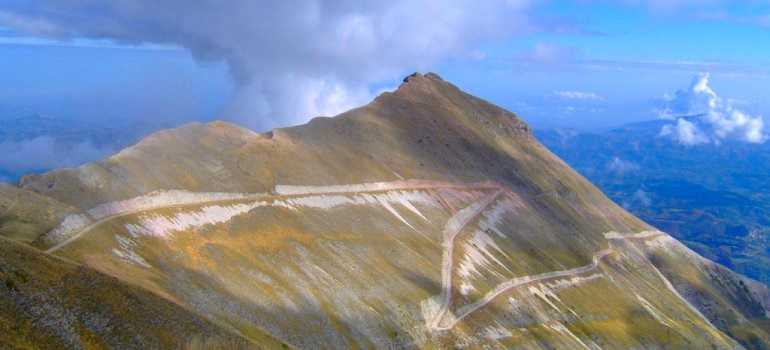

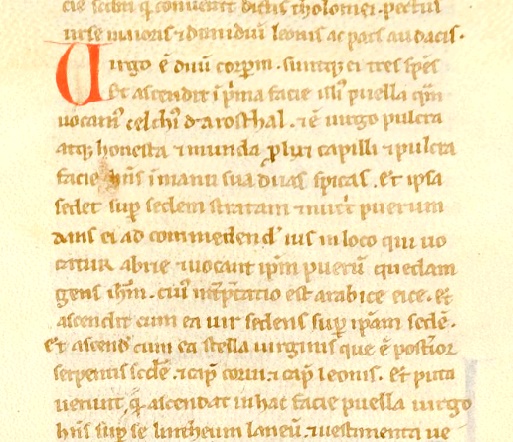

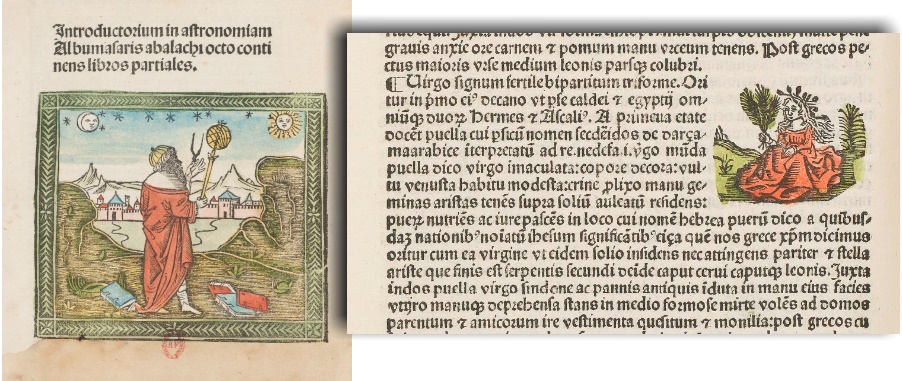

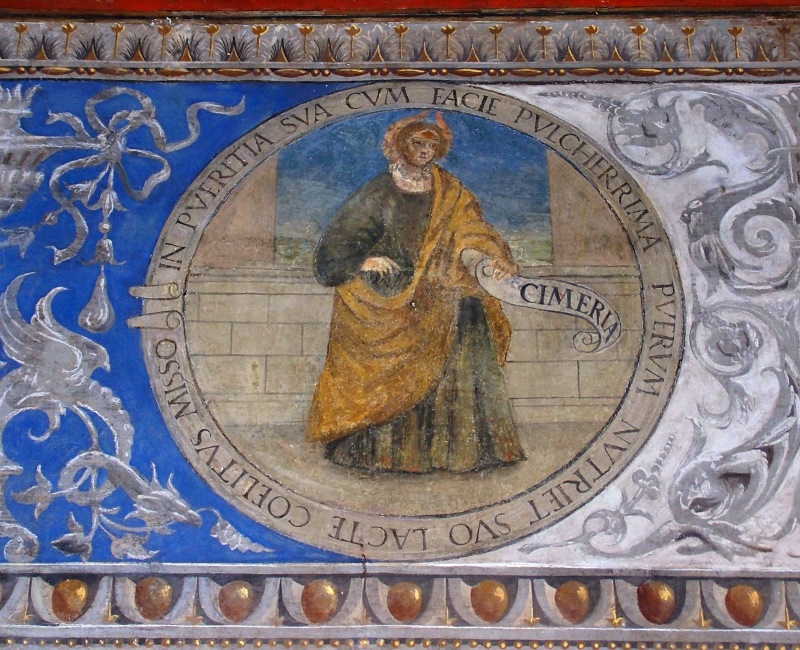

18 Giu 2018
A Sibyl called Cimmerian: exploring the potential link to the Apennine Sibyl - 4. The Sibyl with many names
Is the fourth Sibyl, described by fourth-century author Lactantius in his celebrated enumeration as «Cimmerian», linked in some way to the seventh in the list, the most famous «Cumaean»?
We start to doubt when we consider different ancient editions of Lucius Caecilius Firmianus Lactantius' “De divinis institutionibus”. Because the fourth Sibyl is not always called 'Cimmeriam', as we found in manuscript Latin 1665 preserved at the Bibliothèque Nationale de France.
As a remarkable instance, let's take again the precious edition printed in Subiaco in 1465, one of the first books ever printed in Italy. The excerpt on the fourth Sibyl reads as follows:
«Quartam Cumeam in italia, quam nevius in libris belli punici, piso in annalibus nominant».
The fourth Sibyl has turned into a «Cumeam», a qualifier which appears to have some manifest similarity with the Cumaeam Sibyl.
And we find the same qualifier in a manuscripted versions of the work by Lactantius as well. If we consider a fine Neapolitan edition, dating to the fifteenth century and written in an elegant Italian script (Bibliothèque Nationale de France, Département des Manuscrits, Latin 1674), we find the following:
«Quartam Cumeam in italia, quam Nevius in Libris belli punici, Piso in annalibus nominent».
Again, our Cimmerian Sibyl has become a Cumaeam Sibyl. Note that no reference to any 'Apennine Sibyl' matter can be found at this stage of our search.
And the confusion is not over, because our Sibyl continues to change her attributes. Let's jump in time and space to the renowned benedictine abbey of St. Gall, set at the foot of the Appenzell Alps, in Switzerland. There, in the amazingly gorgeous Library Hall, a jewel of the eighteenth century, is preserved the world's last existing instance of the “Oracula Sibyllina”, a book printed between 1461 and 1465.
The “Oracula Sibyllina” is an early instance of a Christian-oriented rearrangement of the classical list of ten Sibyls set by Lactantius, in the footsteps of such early-Christian authors as Augustine of Hippo and Isidore of Seville, who maintained that Sibyls were included in the vast plan devised by God to announce the Incarnation of Jesus on earth. In this book, for the first time, Sibyls are listed in the number of twelve, with the inclusion of two additional oracles, the Agrippine Sibyl and the European Sibyl.
Here is what St. Gall's book states about our enigmatic Cimmerian Sibyl:
«The Cyemerian Sibyl, eighteen years old, born in Italy, about whom Albumazar the astrologer writes, in a specific prophecy, that a virgin will feed a child».
[In the original Latin text: «Sibilla Cyemeria annorum XVIII in ytalia nata de qua scribit albumazar astrologus vaticinatur commodo virgo lactat puer»].
Now our Cimmerian Sibyl - just like all other Sibyls - has been fully enrolled as a herald of the coming of Jesus, having also been provided - and the same applies to all other sibilline oracles - with an appropriate prophecy on the subject, contained in the caption set below the drawing and describing a maiden (the Holy Mary) that will feed a child (Jesus) with her milk:
«In its first decan of the sign of Virgin, a maiden will rise, honest and pure and handsome in her face, with long hair, sitting in a throne and feeding a child giving milk to him [...] and the child is called among the nations Jesus...».
[In the original Latin text: «In prima facie virginis ascendit virgo quedam honesta et munda et est pulchra facie prolixi capilli sedens super sedem stratam nutriens puerum dans ei ad comedendum lac quem quedam gens vocat Jhesum»].
As you can see, the matter is getting increasingly intricated. And who on earth is «Albumazar the astrologer»? This new element concerning the Cimmerian Sibyl will need further investigation, and sure enough it is not the one and only.
Because we find out the our Cimmerian Sibyl enjoys additional names and further alleged quotes as well. Let's enter into the pages of a very rare book: the “Opuscula”, a miscellaneous book written by Filippo Barbieri, a dominican friar born in Siracusa (Sicily) in 1426. In a 1520 printed edition of Barbieri's work, the first three oracles bear the same names as in “De divinis institutionibus” (Persian, Lybian, Delphic); but then, we find other stunning names for the fourth Sibyl:
«Chimerian Sibyl, who was born in Italy and is also known as Chemical, wearing a heavenly golden garment, with long parted hair down to her shoulders, and young; of her Ennius reports the following: in the first period of the Virgin, a young lady of charming aspect and long hair will rise, sitting on a throne and feeding a child with a right nourishment, a milk sent down from heaven».
[In the original Latin text: «Sybilla chimeria in Italia nata, alias Chimica, vestita celestina veste deaurata capillis per scapulas spartis, et iuvenis de qua Ennius sic ait: in prima facie virginis ascendit puella pulchra facie prolixa capillis; sedens super sedem stratam, nutrit puerum, dans ei ad comedendum ius proprium, idest lac de celo missum»].
The Cimmerian, now turned into «Chimerian» and providing almost the same Christian-oriented prophecy we already saw in St. Gall's “Oracula Sibyllina”, has just earned another qualifier: «Chimica» («Chemical» in English), and with this new name she will often appear in subsequent enumerations of Sibyls. We also find that ancient Roman author Ennius is mentioned as a source about this Sibyl, while no «Albumazar astrologer» is referenced here. And we also find here the very same words we had already retrieved in Claudius Ptolemaeus' “Cosmographia”, in the version published in Ulm by Johann Reger in 1484: «... vestita celestia veste, de aurata capillis per scapulas spartis et iuvenis, de qua enni ait...», one of the sources used by Francesco Maurolico in his passages on the fourth Sibyl.
Thus, our erratic Cimmerian Sibyl seems to shun our investigation: she pops up from time to time across the centuries with different names, attributes and references to literary sources. And we continue to miss any link to the legend and lore of the Apennine Sibyl, a link that only Francesco Maurolico, the Sicilian abbot, seems to allege.
So what can we do now?
There is still a step to take: we need to go back to the root of the Cimmerian / Cumaean sibilline tale, a track already pointed to us by Lactantius' “De divinis institutionibus”. We need to return to Cumae, the antique Greek colony established in southern Italy, and the ancestral home of the seventh Sibyl.
And, perhaps, we will find there the answers we are so eagerly looking for.
Una Sibilla chiamata Cimmeria: un'investigazione sulla possibile relazione con la Sibilla Appenninica - 4. La Sibilla dai molti nomi
È possibile che la quarta Sibilla, menzionata da Lattanzio, scrittore del quarto secolo, nella propria celebre elencazione con l'appellativo di «Cimmeria», sia collegata in qualche modo con il settimo oracolo contenuto nella stessa lista, la «Cumana»?
Effettivamente si comincia a dubitare di ciò quando si prendano in considerazione differenti edizioni antiche dell'opera “De divinis institutionibus” di Lucio Cecilio Firmiano Lattanzio. Perché la quarta Sibilla non viene affatto chiamata sempre 'Cimmeria', come avevamo rilevato nel manoscritto latino n. 1665 conservato presso la Bibliothèque Nationale de France.
A titolo di esempio, andiamo a considerare nuovamente la preziosa edizione stampata a Subiaco nel 1465, uno dei primi volumi a stampa mai prodotti in Italia. Qui, il brano sulle Sibille si presenta nel seguente modo:
«Quartam Cumeam in italia, quam nevius in libris belli punici, piso in annalibus nominant».
La quarta Sibilla si è dunque trasformata in «Cumeam», un appellativo che pare mostrare una palese somiglianza con quello che qualifica la Sibilla Cumana.
E troviamo lo stesso aggettivo anche in varie versioni manoscritte dell'opera di Lattanzio. Se andiamo a prendere una pregevole edizione napoletana, databile al quindicesimo secolo e redatta con un'elegante grafìa in stile italico (Bibliothèque Nationale de France, Département des Manuscrits, Latin 1674), ecco cosa possiamo trovare:
«Quartam Cumeam in italia, quam Nevius in Libris belli punici, Piso in annalibus nominent».
Di nuovo, la nostra Sibilla Cimmeria si è mutata in una Sibilla Cumea. E si noti che nulla, a questo stadio della nostra ricerca, pare finora condurci in direzione dei racconti leggendari che riguardano la 'Sibilla Appenninica'.
E la confusione non termina certo qui, perché la nostra Sibilla continua a vedere modificate le proprie attribuzioni. Saltiamo infatti nel tempo e nello spazio fino alla rinomata abbazia benedettina di San Gallo, posta ai piedi delle Alpi dell'Appenzell, in Svizzera. Qui, nella splendida e affascinante Sala della Biblioteca, un gioiello del diciassettesimo secolo, è conservato uno degli ultimi esemplari che esistano al mondo degli "Oracula Sibyllina", un volume stampato tra il 1461 e il 1465.
Gli "Oracula Sibyllina" costituiscono uno tra gli esempi più risalenti di quella riconfigurazione in senso cristiano della classica lista delle dieci Sibille definita da Lattanzio, sulle orme di autori quali Agostino di Ippona e Isidoro di Siviglia, i quali avevano affermato, molti secoli prima, come le Sibille facessero parte del grande disegno predisposto da Dio affinché fosse preannunciata al mondo l'Incarnazione del Cristo. In questo libro, per la prima volta, le Sibille sono elencate in numero di dodici, con l'inserimento di due oracoli aggiuntivi, la Sibilla Agrippina e la Sibilla Europea.
Ed ecco cosa ci dice il libro di San Gallo a proposito della nostra enigmatica Sibilla Cimmeria:
«La Sibilla Cyemeria, di anni diciotto, nata in Italia, della quale scrive l'astrologo Albumazar, in un appropriato vaticinio, che una vergine allatterà un bambino».
[Nel testo originale latino: «Sibilla Cyemeria annorum XVIII in ytalia nata de qua scribit albumazar astrologus vaticinatur commodo virgo lactat puer»].
Dunque adesso la nostra Sibilla Cimmeria - come tutte le altre Sibille - è stata pienamente arruolata in qualità di araldo della venuta di Cristo, essendo stata anche dotata - e parimenti accade a tutti gli altri oracoli sibillini - di un'opportuna profezia a tema, indicata nella didascalia posta al di sotto della raffigurazione, un annuncio profetico che prefigura una fanciulla (la Vergine Maria) la quale nutrirà un figlio (Gesù) con il proprio latte:
«Nella prima decade del segno della Vergine, una vergine sorgerà, pura e onesta e dal volto armonioso, lunghi i capelli, assisa su di un trono e intenta a nutrire un fanciullo dando a lui del latte, fanciullo che le genti chiamano Gesù...».
[Nel testo originale latino: «In prima facie virginis ascendit virgo quedam honesta et munda et est pulchra facie prolixi capilli sedens super sedem stratam nutriens puerum dans ei ad comedendum lac quem quedam gens vocat Jhesum»].
Come si può notare, la materia sta diventando ancor più complicata e intricata. E chi è mai «Albumazar l'astrologo»? Questo nuovo elemento, che va a caratterizzare ulteriormente la Sibilla Cimmeria, necessita certamente di ulteriore investigazione; e certamente non è nemmeno l'unico.
Perché, proseguendo con la nostra ricerca, scopriamo che la nostra Sibilla Cimmeria è destinataria di ulteriori attributi, nonché di nuove e presunte citazioni. Entriamo allora nelle pagine di un libro estremamente raro: gli "Opuscula", un'opera miscellanea scritta da Filippo Barbieri, un frate domenicano nato a Siracusa nel 1426. In un'edizione del libro di Barbieri stampata nel 1520, i primi tre oracoli sono denominati con gli stessi appellativi già reperiti nel “De divinis institutionibus” (Persica, Libica, Delfica); ma, poi, ci imbattiamo in nuovi stupefacenti nomi attribuiti alla quarta Sibilla:
«Sibilla Chimeria, nata in Italia, conosciuta anche come Chimica, vestita con un dorato abito celestiale, i capelli che le scendono spartiti sulle spalle, e giovane; di lei così parlò Ennio: nel primo periodo della Vergine una fanciulla sorgerà, dal volto armonioso, lunghi i capelli, assisa su di un trono, intenta a nutrire un fanciullo, sostentandolo con appropriato nutrimento, un latte inviato dal cielo».
[Nel testo originale latino: «Sybilla chimeria in Italia nata, alias Chimica, vestita celestina veste deaurata capillis per scapulas spartis, et iuvenis de qua Ennius sic ait: in prima facie virginis ascendit puella pulchra facie prolixa capillis; sedens super sedem stratam, nutrit puerum, dans ei ad comedendum ius proprium, idest lac de celo missum»].
La Cimmeria, ora divenuta «Chimeria» e annunciante quasi la medesima profezia che abbiamo avuto occasione di vedere negli "Oracula Sibyllina" conservati a San Gallo, si è appena guadagnata un ulteriore appellativo: «Chimica», e proprio con questo nome essa apparirà spesso in successivi cataloghi di Sibille. Troviamo anche che l'antico autore latino Ennio viene qui menzionato come fonte di una citazione concernente questa Sibilla, mentre sparisce del tutto il riferimento a «Albumazar l'astrologo». Infine, troviamo anche qui le stesse parole che avevamo già potuto reperire nella "Cosmographia" di Claudio Tolomeo, nella versione pubblicata a Ulm da Johann Reger nel 1484: «... vestita celestia veste, de aurata capillis per scapulas spartis et iuvenis, de qua enni ait...», una delle fonti utilizzata da Francesco Maurolico per scrivere i suoi brani sulla quarta Sibilla.
E così, la nostra erratica Sibilla Cimmeria sembra sfuggire ad ogni nostro tentativo di investigazione: essa appare di volta in volta, attraverso i secoli, con differenti appellativi, attributi e riferimenti a precedenti fonti letterarie. E continua a risultare mancante ogni possibile connessione con la leggendaria tradizione della Sibilla Appenninica, un legame che solo Francesco Maurolico, l'abate siciliano, pare sostenere.
Dunque cosa possiamo fare ora?
C'è ancora un passo che dobbiamo intraprendere: dobbiamo tornare alle radici del racconto mitico che narra della Sibilla Cimmeria / Cumea, un sentiero già indicatoci dallo stesso Lattanzio nel suo trattato “De divinis institutionibus”. Dobbiamo tornare a Cuma, l'antica colonia fondata dai Greci nell'Italia meridionale, e dimora ancestrale della settima Sibilla.
E là, forse, potremo trovare quelle risposte che stiamo ancora così ardentemente cercando.
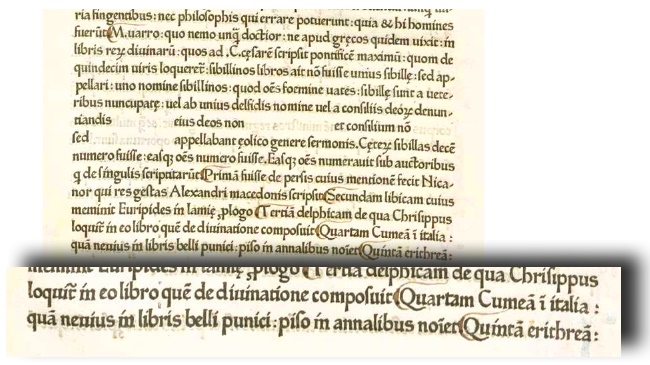

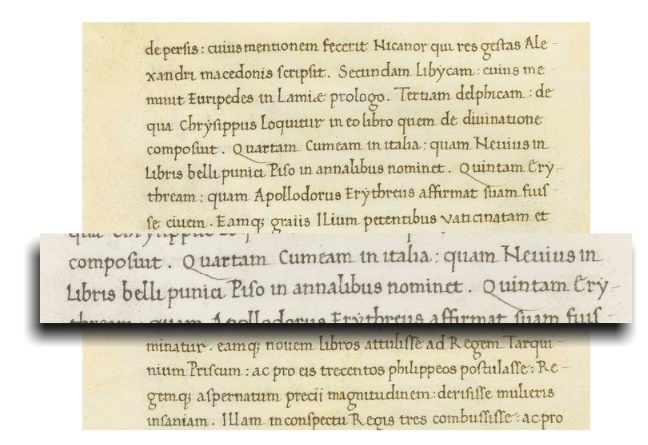

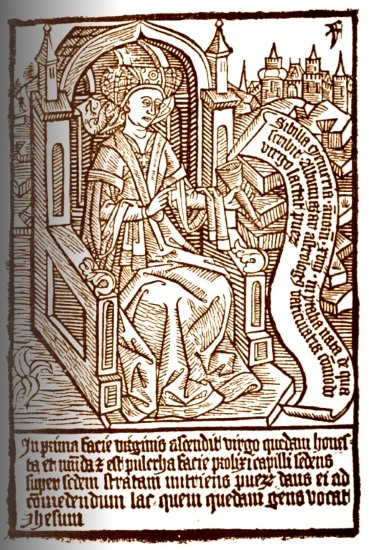

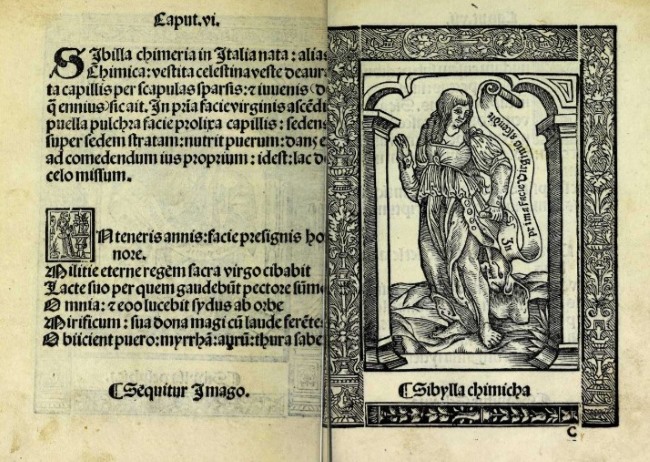

14 Giu 2018
A Sibyl called Cimmerian: exploring the potential link to the Apennine Sibyl - 3. The enigmatic fourth Sibyl
Lucius Caecilius Firmianus Lactantius, a fourth-century early-Christian author, was by no means a minor personage: he was a high-rank advisor to Emperor Constantine the Great and tutor to Emperor's son Crispus.
In his most famous work, “De Divinis Institutionibus”, he provides a remarkable quote drawn from Marcus Terentius Varro, who in turn, in a book that has now gone lost, set down what is considered as the canonical list of ten Sibyls belonging to ancient, classical times.
«It is known that Sibyls were ten in number. Marcus Varro enumerated them all under the writers, who wrote an account of each. The first was from the Persians, and of her Nicanor made mention, who wrote the deeds of Alexander of Macedon. The second was of Libya...»
[In the original Latin text: «Ceterum Sibillas decem numero fuisse. Easquem omnes [M. Varro] numeravit sub auctoribus, qui de singulis scriptitarunt. Primam fuisse de Persis, cujus mentionem fecerit Nicanor, qui res gestas Alexandri Macedonis scripsit. Secundam Libicam...»].
Such are the words by Lactantius, which we will review in further detail in a future article. For the time being, it is sufficient to analyse what he states about the Cumaean Sibyl (in the figure, the oracle as portrayed by Domenico "Domenichino" Zampieri in a painting preserved at the Galleria Borghese in Rome), and the Cimmerian.
The following are Lactantius's words on the Sibyl from Cumae, as taken from a most valuable edition of “De Divinis Institutionibus” printed in 1465 at the benedictine abbey of Subiaco, Italy (see figure) and reporting the renowned episode of the books offered to the King of Rome by the clever oracle:
«... The seventh was of Cumae, by name Amalthaea, who is termed by some Demophile and they say that she brought nine books to the king Tarquinius Priscus, and asked for them three hundred philippics [a golden currency from the antique kingdom of Macedon], and that the king refused so great a price, and derided the madness of the woman; that she, in the sight of the king, burnt three of the books, and demanded the same price for those which were left; that Tarquinias much more considered the woman to be mad; and that when she again, having burnt three other books, persisted in asking the same price, the king was moved, and bought the remaining books for the three hundred pieces of gold: and the number of these books was afterwards increased, after the rebuilding of the Capitol; because they were collected from all cities of Italy and Greece, and especially from those of Erythrae, and were brought to Rome, under the name of whatever Sibyl they were».
[In the original Latin text: «Septimam Cumanam nomine Amaltheam, quae ab aliis Demophile nominatur; eamque novem libros attulisse ad regem Tarquinium priscum, ac pro eis trecentos philippeos postulasse; regemque aspernatum pretii magnitudinem, derisisse mulieris insaniam: illam in conspectu regis tres combussisse, ac pro reliquis idem pretium postulasse: Tarquinium multo magis mulierem insanire putasse. Quae denuo tribus aliis exustis, cum in eodem pretio perseveraret, motum esse regem, ac residuos trecentis aureis emisse: quorum postea numerus sit auctus, Capitolio refecto, quod ex omnibus civitatibus et Italicis, et Graecis, et praecipue Erythraeis coacti, allatique sunt Romam, cuiuscumque Sibyllae nomine fuerunt»].
That was for the Cumaean; but what about the Cimmerian Sibyl? In the classical enumeration by Lactantius, she stands out at number four, as we can read in a most precious fourteenth-century manuscript of “De divinis institutionibus” preserved at the Bibliothèque Nationale de France (Latin 1665 - see figure):
«The fourth a Cimmeriam in Italy, whom Naevius mentions in his book on the Punic war, and Piso in his annals».
[In the original Latin text: «Quartam Cimmeriam in ytalia, quam Nevius in libris belli punici Piso in annalibus nominat»].
According to Lactantius, the Cimmeriam Sibyl - like the Cumaean and the Tiburtine - is an Italian Sibyl. But where was her shrine situated? Perhaps, was it in the Apennines? Lactantius says nothing about that.
We may possibly turn to the two authors mentioned in this excerpt, 'Naevius' and 'Piso', from whim Lactantius took the mentions on the Cimmeriam Sibyl. However, their works are unfortunately lost to us, they are not extant anymore, so we cannot read into the pages of their books.
Gnaeus Naevius, an epic poet who was born in Campania in the early third century B.C., was the author of a “Bellum Poenicum”, a poetic work on the First Punic War and the story of the foundation of Rome: only fifty small literary fragments pertaining to this book are available today, and no known fragment mentions the sibilline topic at all.
Lucius Calpurnius Piso Frugi was a Roman consul in year 133 B.C. As a Latin author, he wrote the “Annales” (“Chronicles”), a work on the origin and history of Rome. Piso's books are lost too, and the few extant excerpts are not relevant to Sibyls.
So where should we turn to unveil the origin and whereabouts of the Cimmerian Sibyl?
The answer is not too far from us. Or, to be more specific, it is not too far from a place we already know.
That place is not the Apennines, as we would be glad to find out. That place, strange as it may be, is Cumae again: the Cimmerian Sibyl appears to be linked to the Cumaean oracle. Let's go and investigate why.
Una Sibilla chiamata Cimmeria: un'investigazione sulla possibile relazione con la Sibilla Appenninica - 3. L'enigma della quarta Sibilla
Lucio Cecilio Firmiano Lattanzio, un autore protocristiano del quarto secolo, non era affatto un personaggio secondario: egli fu infatti consigliere di elevatissimo rango dell'Imperatore Costantino il Grande, nonché precettore di Crispo, figlio dello stesso Imperatore.
Nella sua opera più nota, "De Divinis Institutionibus", egli riporta una significativa citazione tratta da Marco Terenzio Varrone, il quale, a propria volta, in un libro andato oggi perduto, stabilisce quello che è considerato come l'elenco canonico delle dieci Sibille appartenute al mondo classico.
«È noto come le Sibille siano state in numero di dieci. Tutte furono elencate [da Marco Varrone] sulla base degli autori che scrissero a proposito di ognuna. La prima fu la Persica, che fu menzionata da Nicanore, il quale celebrò le gesta di Alessandro il Macedone. La seconda, Libica...»
[Nel testo originale Latino: «Ceterum Sibillas decem numero fuisse. Easquem omnes [M. Varro] numeravit sub auctoribus, qui de singulis scriptitarunt. Primam fuisse de Persis, cujus mentionem fecerit Nicanor, qui res gestas Alexandri Macedonis scripsit. Secundam Libicam...»].
Tali sono le parole di Lattanzio, che avremo modo di considerare in maggior dettaglio in un futuro articolo. Per il momento, ci limiteremo ad analizzare ciò che egli scrive a proposito dellla Sibilla Cumana (in figura, l'oracolo rappresentato da Domenico Zampieri, il "Domenichino", in un dipinto conservato presso la Galleria Borghese in Roma), e della Cimmeria.
Quello che segue è ciò che scrive Lattanzio in merito alla Sibilla di Cuma, così come tratto da una preziosissima edizione dell'opera “De Divinis Institutionibus” stampata presso l'abbazia benedettina di Subiaco nel 1465 (vedere figura), e contenente il racconto del beffardo episodio relativo ai libri offerti al Re di Roma dall'astuto oracolo:
«... La settima fu Cumana, chiamata Amaltea, che alcuni chiamano Demofile; di lei si narra come avesse portato al re Tarquinio Prisco nove libri, chiedendo per essi trecento filippi [una moneta aurea dell'antico regno di Macedonia], e di come il re si fosse rifiutato di pagare un prezzo così elevato e si fosse preso gioco della follia della donna; e di come essa, di fronte agli occhi del re, avesse bruciato tre di quei libri, per poi chiedere, per i restanti, il medesimo prezzo. Tarquinio ancor più grande reputò essere la pazzia di quella donna; e quando ella ebbe bruciato tre ulteriori libri, perseverando nel richiedere lo stesso prezzo, il re infine si convinse e acquistò i tre libri che rimanevano per trecento monete d'oro. Tale numero fu poi incrementato, dopo la ricostruzione del Campidoglio, essendone acquisiti altri presso molte città dell'Italia e della Grecia, e in particolare da Eritre, e portandoli a Roma, a qualsiasi Sibilla fossero essi appartenuti».
[Nel testo originale latino: «Septimam Cumanam nomine Amaltheam, quae ab aliis Demophile nominatur; eamque novem libros attulisse ad regem Tarquinium priscum, ac pro eis trecentos philippeos postulasse; regemque aspernatum pretii magnitudinem, derisisse mulieris insaniam: illam in conspectu regis tres combussisse, ac pro reliquis idem pretium postulasse: Tarquinium multo magis mulierem insanire putasse. Quae denuo tribus aliis exustis, cum in eodem pretio perseveraret, motum esse regem, ac residuos trecentis aureis emisse: quorum postea numerus sit auctus, Capitolio refecto, quod ex omnibus civitatibus et Italicis, et Graecis, et praecipue Erythraeis coacti, allatique sunt Romam, cuiuscumque Sibyllae nomine fuerunt»].
Questo è quanto riporta Lattanzio a proposito della Cumana. Ma cosa afferma il nostro autore, invece, in merito alla Sibilla Cimmeria? Nella classica elencazione redatta dal consigliere imperiale, quest'ultima compare nella quarta posizione, come possiamo leggere in un preziosissimo manoscritto dell'opera “De Divinis Institutionibus” risalente al quattordicesimo secolo e conservato presso la Bibliothèque Nationale de France (Latin 1665 - vedere figura):
«La quarta è Cimmeria, in Italia, che Nevio menziona nei suoi libri sulla guerra punica e Pisone nei propri annali».
[Nel testo originale latino: «Quartam Cimmeriam in ytalia, quam Nevius in libris belli punici Piso in annalibus nominat»].
Secondo quanto riferisce Lattanzio, la Sibilla Cimmeria - così come anche la Cumana e la Tiburtina - è una Sibilla italica. Ma dove era collocato il suo santuario? È possibile che fosse situato tra i monti dell'Appennino? Lattanzio, a questo proposito, non dice nulla.
Potremmo forse tentare di rivolgerci ai due autori classici menzionati in questo brano, 'Nevio' e 'Pisone', dai quali Lattanzio trasse i propri riferimenti alla Sibilla Cimmeria. Purtroppo, però, le opere di questi due autori sono andate perdute: esse non esistono più, e così non possiamo più leggere ciò che fu scritto in questi antichi libri.
Gneo Nevio, un poeta epico nato in Campania nella prima metà del terzo secolo a.C., fu l'autore di un "Bellum Punicum", un'opera poetica che narrava le vicende della Prima Guerra Punica e le storie della fondazione di Roma: di questo libro, sopravvivono oggi soltanto cinquanta piccoli frammenti testuali, e nessuno di essi è relativo al tema degli oracoli sibillini.
Lucio Calpurnio Pisone Frugi è stato console romano nell'anno 133 a.C. Fu l'autore degli "Annales", un'opera sulle origini e sulla storia di Roma. Anche i volumi di Pisone sono andati perduti, e nessuno dei frammenti sopravvissuti riguarda le Sibille.
E dunque, in quale altro modo possiamo tentare di disvelare l'origine e la collocazione della Sibilla Cimmeria?
La risposta non è poi così distante dai nostri occhi. O, per essere più specifici, non è così lontana da un luogo che già conosciamo.
Questo luogo non si trova tra gli Appennini, come saremmo certamente lieti di scoprire. Il posto giusto, per quanto possa apparire strano, è sempre e ancora Cuma: la Sibilla Cimmeria pare possedere una stretta relazione con l'oracolo cumano. Andiamo a investigare perché.


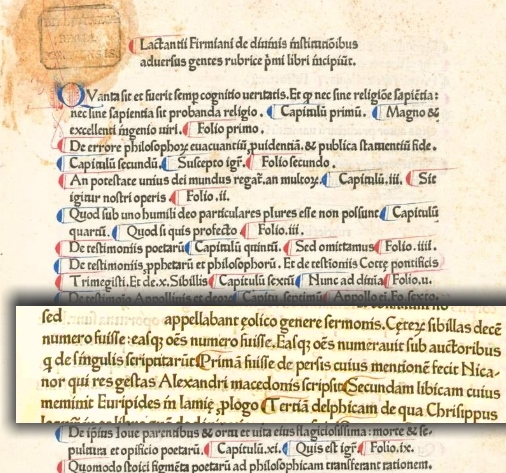

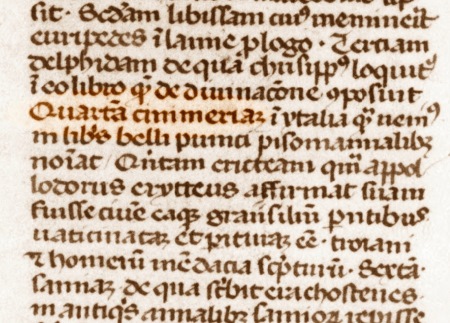

10 Giu 2018
A Sibyl called Cimmerian: exploring the potential link to the Apennine Sibyl - 2. A Cimmerian connection
In the fifteenth-century romance “Guerrino The Wretch”, Andrea da Barberino presents a Sibyl who lives under a mountain in the vicinity of Norcia: an oracle who declares that she is the Cumaean Sibyl, after having established her abode in the Apennine ridge, far from the ancient town of Cumae.
However, Francesco Maurolico, an abbot and scholar who lived in Messina (southern Italy) in the sixteenth century, does not agree with such an identification at all. In a number of different passages from his “Topographia Sanctorum Christi Martyrum”, published in 1568, he clearly states that the Apennine Sibyl is to be considered as the Cimmerian Sibyl, one of the ten classical oracles listed in Lactantius' most renowned “De Divinis Institutionibus”, a work written in the fourth century.
In a previous paper, we already published Maurolico's mentions concerning the Sibyl of Norcia; we review all of them here, for the reader's convenience:
«Ameria, an Italian town set in the Sabine region. From this town the author names the 'Emerian Sibyl', who others call the 'Cimeriam' owing to the uncertainty of the place; she lives in the caverns of Norcia, and is different from both the Cumaean and the Tiburtine Sibyls [...] Norcia, a town of the Italian region of Picenum; close to it is the Cavern of the Cimeriam Sibyl, and the lake of Demons [...] The fourth Sibyl is the Cumaeam, whom Naevius mentions in his books about the Punic war, and Piso in his annals as well; from the Cimeriam castle, also known as the Cave of Norcia, which some call by the corrupted name of 'Cymea' or 'Cymica' [...] Cumae, a town of Campania lying by the gulf of Baiae. Here was the Cumaean Sibyl, who was also called Deiphobe, and by some named as Cimmeria or Cymica, but in truth the latter is a different one in the cavern of Norcia».
[In the original Latin excerpts: «Ameria civitas Italiae in Sabinis. Hinc denominat author Sybillam Emeriam, quam alii Cimeriam vocant ab oscuritate loci, et in Nurcinis antris habitantem, atque a Cumana, et a Tyburtina diversam [...] Nurcia civitas Italiae in agro Piceno, iuxta quam est Antrum Sibyllae Cymeriae, et lacus Daemonum [...] Quartam Cumaema in Italia, quam Nevius in libris belli punici, Piso autem in annalibus nominat; ex Cimerio oppido, sive Antro nurcino, quae corrupto forte verbo Cymea, vel Cymica vocetur a nonnullis [...] Cumae Campaniae civitas in sinu Baiarum. Hic fuit Cumana Sibylla, quae Deiphobe vocatur, quae a nonnullis Cimmeria, vel Cymica dicitur, nisi haec alia sit ex antro Nurcino»].
In Maurolico's “Topographia”, a catalogue of places connected to the presence of God on earth, he repeatedly states that the Sibyl of Norcia has nothing to do with the Cumaean Sibyl, as her lineage goes back to a very different classical Sibyl. He shows no hesitation: the Sibyl of Norcia is the Emeriam - or Cimeriam, Cymeriam, Cymea, Cymica, Cimmeria - who lived in ancient times in a small town called Ameria or Cimeria, lying not far from Norcia, where the Sibyl's cave stands.
Was Francesco Maurolico right? Was a village named Ameria or Cimeria really extant in the vicinity of Norcia? Is the Sibyl of the Apennines really descending from a Cimmeriam Sibyl? And what does 'Cimmerian Sibyl' stand for?
In a preceding article, we saw that Maurolico did not take the above information from his recognised primary source, Jean Germain's “Mappemonde Spirituelle”, a work written in the fifteenth century. Furthermore, in addition to what we stated in that article, we can now show that Maurolico drew part of the information he wrote on the fourth Sibyl from another fifteenth-century work (whom Maurolico himself mentions in his introductory notes to his “Topographia”). As a matter of fact, we find almost the same wording used by Maurolico as to the «Ameria civitas» in Claudius Ptolemaeus' “Cosmographia”, in the version published in Ulm by Johann Reger in 1484. This book contains an introductory «Registrum Alphabeticum» listing a large number of geographical names referred to by Ptolemy, and - under letter 'A' - we find the following:
«Ameria (Book 3, Chapter 1, Map 6 of Europe). Here the fourth Sibyl was born. The Emerian Sibyl was born in Italy and is also known as Chemical, wearing a heavenly golden garment, with long parted hair down to her shoulders, and young; of her Ennius reports: in the first period of the Virgin, a young lady of charming aspect and long hair will rise, sitting on a throne and feeding a child with a right nourishment, a milk sent down from heaven».
[In the original Latin text: «Ameria li 3 ca 1 ta 6 europe Hic nascitur quarta sibilla. Sibilla emeria in ytalia nata, alias chimica vestita celestia veste, de aurata capillis per scapulas spartis et iuvenis, de qua enni ait. In prima facie virginis ascendit puella pulchra facie, plixa capillis, sedens super sedem stratam nutrit puerum, dans ei ad comedendum ius proprium, id est lac de celo missum»].
What does it all mean? Who is the fourth Sibyl? Why is she portrayed in a such a peculiar way? And why Maurolico seems to quote from this excerpt when he mentions the unknown town of «Ameria», although no reference is found in Reger's Ptolemy as to Norcia and its Sibyl's cave?
The matter is very complex and, at first sight, utterly puzzling. However, we will try to solve the many riddles concealed in the above excerpts, conferring an identity and a place of birth to the fourth Sibyl, the Cimmerian.
For a better understanding of the issue, we need to go back to Lucius Caecilius Firmianus Lactantius' enumeration of ten classical Sibyls, and meet, in a close encounter, the original Cimmerian Sibyl.
Una Sibilla chiamata Cimmeria: un'investigazione sulla possibile relazione con la Sibilla Appenninica - 2. L'ipotesi cimmeria
Nel romanzo quattrocentesco "Guerrin Meschino", Andrea da Barberino ci presenta una Sibilla che vivrebbe al di sotto di una montagna posta non lontano da Norcia: un oracolo che descrive se stesso come la Sibilla Cumana, trasferitasi tra le vette degli Appennini, e dunque molto lontano dall'antica città di Cuma.
Eppure, l'abate Francesco Maurolico, un erudito vissuto in Messina nel sedicesimo secolo, dichiara di non essere affatto d'accordo con questa identificazione. In vari passaggi della sua “Topographia Sanctorum Christi Martyrum”, pubblicata nel 1568, egli si presenta come convinto sostenitore dell'ipotesi che la Sibilla Appenninica coincida in realtà con la Sibilla Cimmeria, uno dei dieci oracoli classici elencati nella notissima opera di Lattanzio “De divinis institutionibus”, risalente al quarto secolo.
In un precedente articolo, abbiamo già avuto occasione di pubblicare i riferimenti proposti da Maurolico in merito alla Sibilla di Norcia; li riproponiamo integralmente qui, per maggiore comodità del lettore:
«Ameria, città dell'Italia posta nella regione Sabina. Da questa città l'autore denomina la 'Sibilla Emeria', che altri chiamano 'Cimeria' a causa dell'incertezza sul luogo; essa vive nell'antro di Norcia, ed è diversa sia dalla Cumana che dalla Tiburtina [...] Norcia, una città d'Italia nella regione del Piceno, vicino alla quale si trova l'Antro della Sibilla Cimeria, e il lago dei Dèmoni [...] La quarta Sibilla è la Cumea, di cui parla Nevio nei suoi libri dedicati alla Guerra Punica, a anche Pisone nei suoi annali; dal castello Cimerio, conosciuto anche con il nome di Antro nursino, che alcuni chiamano con il nome corrotto di 'Cymea' o 'Cymica' [...] Cuma, città della Campania nel golfo di Baia. Qui fu la Sibilla Cumana, chiamata anche Deifobe, che alcuni indicano come Cimmeria o Cymica, se questa non fosse un diverso oracolo posto nella caverna di Norcia».
[Nel testo originale latino: «Ameria civitas Italiae in Sabinis. Hinc denominat author Sybillam Emeriam, quam alii Cimeriam vocant ab oscuritate loci, et in Nurcinis antris habitantem, atque a Cumana, et a Tyburtina diversam [...] Nurcia civitas Italiae in agro Piceno, iuxta quam est Antrum Sibyllae Cymeriae, et lacus Daemonum [...] Quartam Cumaema in Italia, quam Nevius in libris belli punici, Piso autem in annalibus nominat; ex Cimerio oppido, sive Antro nurcino, quae corrupto forte verbo Cymea, vel Cymica vocetur a nonnullis [...] Cumae Campaniae civitas in sinu Baiarum. Hic fuit Cumana Sibylla, quae Deiphobe vocatur, quae a nonnullis Cimmeria, vel Cymica dicitur, nisi haec alia sit ex antro Nurcino»].
Nella “Topographia” redatta da Maurolico, comprendente un catalogo di luoghi presso i quali si rivela la presenza di Dio sulla terra, egli dichiara ripetutamente come la Sibilla di Norcia non abbia nulla a che fare con la Sibilla Cumana, in quanto l'ascendenza della prima sarebbe da riferirsi ad una ben diversa Sibilla classica. Maurolico non mostra alcuna esitazione: la Sibilla di Norcia è l'Emeria - o Cimeria, Cymeria, Cymea, Cymica, Cimmeria - la quale visse nell'antichità in una piccola città chiamata Ameria o Cimeria, che sarebbe sorta nelle vicinanze di Norcia, dove si trova la grotta della Sibilla.
Francesco Maurolico aveva ragione? Esisteva veramente un villaggio il cui nome era Ameria o Cimeria in prossimità di Norcia? La Sibilla Appenninica discende veramente dalla Sibilla Cimmeria? E cosa significa veramente 'Sibilla Cimmeria'?
In un precedente articolo, abbiamo anche visto come Maurolico non abbia tratto queste affermazioni dalla sua fonte primaria, l'opera “Mappemonde Spirituelle” di Jean Germain, compilata nel quindicesimo secolo. Inoltre, a titolo di integrazione rispetto a ciò che scrivemmo in quell'articolo, possiamo oggi mostrare come Maurolico abbia ricavato parte delle informazioni da lui riportate in merito alla quarta Sibilla da un ulteriore volume seicentesco (che lo stesso Maurolico cita nelle sue note introduttive alla "Topographia"). In effetti, possiamo ritrovare quasi le stesse parole menzionate da Maurolico in relazione alla «Ameria civitas» all'interno della "Cosmographia" di Claudio Tolomeo, nella versione pubblicata a Ulm da Johann Reger nel 1484. Questo libro contiene infatti un «Registrum Alphabeticum» introduttivo, nel quale sono elencati un gran numero di nomi di luoghi ai quali Tolomeo ha fatto riferimento, e - sotto la lettera 'A' - ecco cosa possiamo leggere:
«Ameria (Libro 2, Capitolo 1, Tavola 6 dell'Europa). Qui è nata la quarta Sibilla. La Sibilla Emeria è nata in Italia, essendo conosciuta anche come Chimica, vestita con un azzurro abito dorato, con lunghi capelli che le scendono su entrambe le spalle, e giovane; di lei così parlò Ennio: nel primo decano della Vergine, una fanciulla sorgerà di bellissimo aspetto, lunghi i capelli, assisa su di un trono e intenta a nutrire un bambino, al quale darà il nutrimento opportuno, che è latte inviato dal cielo».
[Nel testo originale latino: «Ameria li 3 ca 1 ta 6 europe Hic nascitur quarta sibilla. Sibilla emeria in ytalia nata, alias chimica vestita celestia veste, de aurata capillis per scapulas spartis et iuvenis, de qua enni ait. In prima facie virginis ascendit puella pulchra facie, plixa capillis, sedens super sedem stratam nutrit puerum, dans ei ad comedendum ius proprium, id est lac de celo missum»].
Cosa significa tutto questo? Chi è veramente la quarta Sibilla? Perché essa viene rappresentata in questo modo così peculiare? E perché Maurolico, nel menzionare la sconosciuta città di «Ameria», sembrerebbe riferirsi proprio a questo brano, benché il testo tratto dal Tolomeo nella versione di Reger non contenga affatto alcun riferimento a Norcia e alla Grotta della Sibilla?
L'intera questione pare presentarsi nel modo più complicato e, a prima vista, assolutamente sconcertante. Eppure, noi tenteremo comunque di risolvere i molti enigmi nascosti nei brani che abbiamo citato, assegnando un'identità e un luogo di nascita alla quarta Sibilla, la Cimmeria.
Per una migliore comprensione di tutto ciò, dobbiamo però ripartire dall'enumerazione delle dieci Sibille classiche tramandataci da Lucio Caecilio Firmiano Lattanzio, per affrontare, nel corso di un vero e proprio incontro ravvicinato, la Sibilla originale, quella Cimmeria.
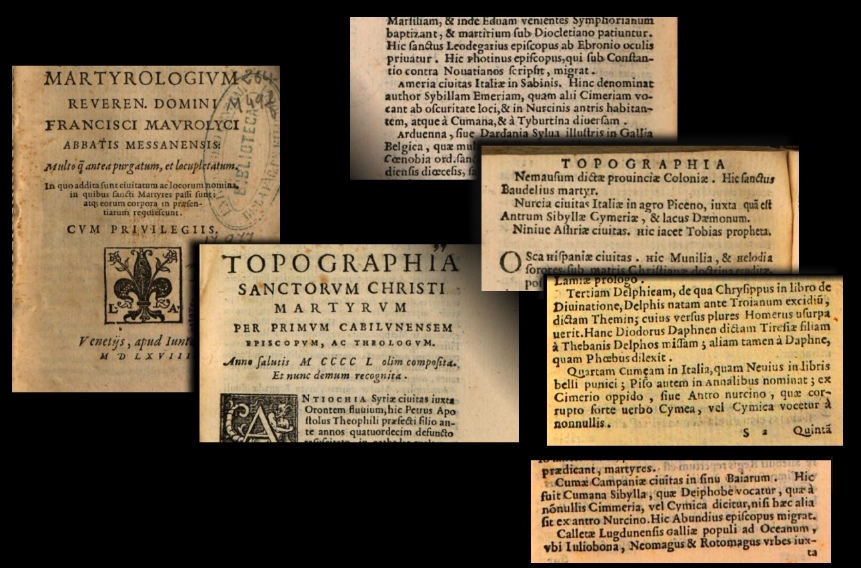

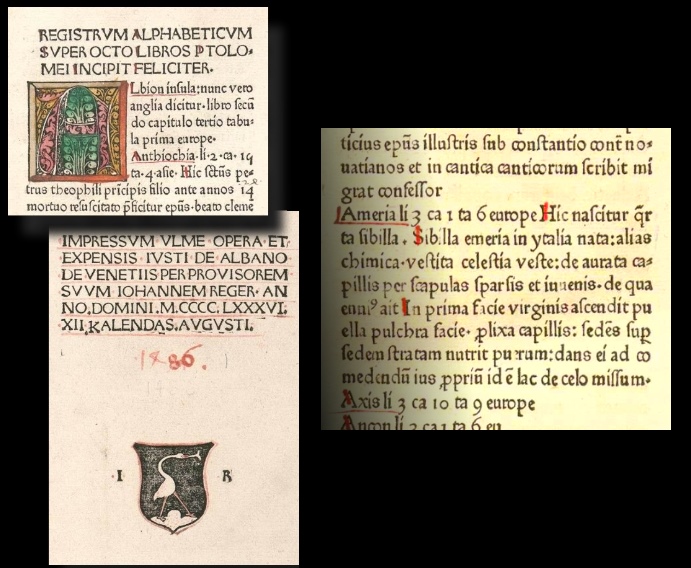

8 Giu 2018
A Sibyl called Cimmerian: exploring the potential link to the Apennine Sibyl - 1. Cumae and Norcia
The Apennine Sibyl, or the Sibyl of Norcia, has been the focus of fascinated attention throughout many centuries, from the fifteenth-century romance “Guerrino The Wretch” by Andrea da Barberino to the late nineteenth-century explorations carried out by the philologist Pio Rajna, and beyond. Dozens and dozens of literary works have mentioned her name and whereabouts, depicting an oracle who would be concealed under the rocky bulk of Mount Sibyl, in the Sibillini Mountain Range, a portion of the Italian Apennines.
According to Andrea da Barberino, the Apennine Sibyl is to be identified with the Cumaean Sibyl, a classical Sibyl who is included in the ancient enumeration provided by Lucius Caecilius Firmianus Lactantius, an author who lived in the fourth century. In the work written by Andrea da Barberino, it's the Sibyl herself who openly declares her own origin:
«I want you to know my name. I was called 'Cumaean' by the Romans for I was born in a town in the countryside whose name is Cuma: before I was sentenced to this place I lived in the world one thousand two hundred years. When Aeneas came to Italy, I led him through the nether world: and I was seven hundred years old at that time [...] And in his time [of Tarquinius Priscus] the Romans came and asked me for laws: and I sent nine books of laws to them. And in that time to my own benefit I asked to remain alive, as much as the world could ever last, until the fair judge will come for the last judgment.».
[In the original Italian text: «Io voglio che tu sapi el mio nome. Io fui chiamata da Romani chumana per che io naqui in una cità de campagna che ha nome chumana: e stete al mondo inanzi che io fosse iudicata in questa parte mille e ducento anni, che quando Enea vene i queste parte zoe in Italia, io lo menai per tuto lo inferno: e havea alhora sete cento anni [...] E nel suo tempo mandareno li Romani a domandare lezie: et io mandai a loro nove libri de lezie. Et in quello tempo per mia scientia mandai a domandare de stare in questa vita: tanto quanto el mondo de durare, et che el dreto iudice vignerà a giudicare»].
In the above excerpt, the main features which the ancient Roman tradition attributed to the Cumaean Sibyl are all mentioned by Andrea da Barberino: her role as a guide to the Otherworld as portrayed in Publius Vergilius Maro's “Aeneid” (Book VI); the nine books of sibilline prophecies offered to King Tarquinius, as reported by Lactantius; the legendary tale about her immortality, which is narrated by Publius Ovidius Naso in his “Metamorphoses”.
Andrea da Barberino also provides an explanation as to the reason for which the Cumaean Sibyl would have moved her abode to a mountain in central Italy. The Sibyl says that she was «sentenced there», a wording that refers to another old lore, dating to the early Christian era: the Sibyl, a virgin like the Holy Mary and her teacher, had conceived the whim that she could be the one to grow the son of God in her own womb; but God himself, who had already chosen Mary, devised to punish her for her unholy arrogance. And when Guerrino asks for information about the whereabouts of the Sibyl, a man tells him that
«I heard that the wise Sibyl was a virginal maid, so that she had hoped that God would enter into her when the Incarnation occurred in the Holy Mary. Because of that different choice she grieved and was then sentenced amid these mountainous ridges».
[In the original Italian text: «Io ho udito dir che ze la savia Sibilla la quale si è vergene in lo mondo che la credea che dio scendesse i(n) lei qua(n)do incarnò in Maria vergine. E per questo lei desperò e fu ziudicata per questa casone in queste montagne»].
But Guerrino's Sibyl is eager to stress that she herself has nothing to do with the Holy Mary, because that was a story connected to another Sibyl, the Albunean (better known as the Tiburtine Sibyl). When Guerrino asks the oracle whether she is the one who «was granted by the grace of God to be the teacher of the virgin who gave birth to the Saviour of our human nature» («havendoti conceduta la divina providentia la gratia che tu fosti maestra de quela verzene in cui incarnò el Salvatore de la humana natura» in Italian), the Sibyl replies harshly to him, by saying that she
«[...] has never been the one who taught our lady [...] The Sibyl you are referring to is called Albunea».
[In the original Italian text: «[...] ella non essere stata quella che insegna a nostra donna [...] La Sibilla che tu voi dire have nome Albunea»].
In the sixteenth century, the Cumaean origin of the Apennine Sibyl is mentioned by Ludovico Ariosto as well. The author of “Orlando Furioso” writes the following words:
«[...] the Cumæan Sibyl [...] who fled, in antiquity, to a Cavern in the territory of Norcia, placed on a mountain-top amidst a gloomy forest, from the charming abode she used to live in at earlier times».
[In the original Italian text: «la Sibilla Cumea, la qual ridotta / s’era in quei tempi a la Nursina grotta / su gli aspri monti in una selva folta / da i luoghi ameni, ove habitava prima»].
The Apennine Sibyl and the Cumaean: a close relationship seems to exist between the two. However, we also have the evidence of a second, different tradition, emerging from a different work written in 1568.
The work is the “Topographia Sanctorum Christi Martyrum”, written by Francesco Maurolico, and it tells us a different story. According to Maurolico, the Sibyl of Norcia is to be identified with another Sibyl: the Cimmerian.
Who is the Cimmerian Sibyl? Is she included in the classical list of ten Sibyls handed over to us by Lucius Caecilius Firmianus Lactantius in the fourth century? And what does Maurolico says about a potential link connecting the Cimmerian Sibyl and the Sibyl of Norcia?
We will now try and tread a new mysterious path in the legends and lore of Sibyls. Don't miss the chance to further step ahead in the enthralling, hidden enigma of the Apennine Sibyl.
Una Sibilla chiamata Cimmeria: un'investigazione sulla possibile relazione con la Sibilla Appenninica - 1. Cuma e Norcia
La Sibilla Appenninica, o Sibilla di Norcia, è stata per molti secoli al centro di un'attenzione affascinata e ininterrotta, a partire dal romanzo quattrocentesco "Guerrin Meschino" di Andrea da Barberino fino a giungere alle esplorazioni compiute nel tardo diciannovesimo secolo dal filologo Pio Rajna, per giungere infine sino a tempi recentissimi.
Decine e decine di opere letterarie hanno menzionato questa Sibilla e i luoghi della sua leggenda, descrivendo un oracolo che si troverebbe nascosto al di sotto della massa rocciosa del Monte Sibilla, nella regione dei Monti Sibillini, una porzione della catena degli Appennini.
Secondo Andrea da Barberino, la Sibilla Appenninica deve essere identificata con la Sibilla Cumana, una delle Sibille classiche incluse nell'antica elencazione tramandataci da Lucio Cecilio Firmiano Lattanzio, un autore vissuto nel quarto secolo. È la Sibilla stessa, nel romanzo scritto da Andrea da Barberino, a dichiarare esplicitamente la propria origine:
«Io voglio che tu sapi el mio nome. Io fui chiamata da Romani chumana per che io naqui in una cità de campagna che ha nome chumana: e stete al mondo inanzi che io fosse iudicata in questa parte mille e ducento anni, che quando Enea vene i queste parte zoe in Italia, io lo menai per tuto lo inferno: e havea alhora sete cento anni [...] E nel suo tempo [Tarquinio Prisco] mandareno li Romani a domandare lezie [leggi]: et io mandai a loro nove libri de lezie. Et in quello tempo per mia scientia mandai a domandare de stare in questa vita: tanto quanto el mondo de durare, et che el dreto iudice vignerà a giudicare».
In questo brano, Andrea da Barberino fa esplicito riferimento a tutti i principali attributi che caratterizzano la Sibilla Cumana nella tradizione antico-romana: il suo ruolo in qualità di guida nell'Oltretomba così come illustrato da Publio Virgilio Marone nell'"Eneide" (Libro VI); i nove libri di oracoli sibillini offerti al Re Tarquinio, così come riferito da Lattanzio; il leggendario racconto della sua immortalità, narratoci da Publio Ovidio Nasone nelle sue "Metamorfosi".
Andrea da Barberino ci propone anche una spiegazione in merito alla ragione per la quale la Sibilla Cumana avrebbe trasferito la propria dimora presso una remota montagna dell'Italia centrale. La Sibilla afferma infatti di essere stata «iudicata in questa parte», una frase che pare riferirsi ad un'altra antica leggenda, risalente agli albori della Cristianità: la Sibilla, una vergine così come anche Maria e maestra di quest'ultima, avrebbe accarezzato l'idea di potere essere lei stessa a portare nel proprio grembo il figlio di Dio; ma Dio stesso, che già aveva prescelto Maria Vergine, deliberò di punire quella Sibilla per la propria blasfema arroganza. E quando Guerrino tenta di informarsi su dove egli debba recarsi per incontrare la Sibilla, un uomo gli risponde nel modo seguente:
«Io ho udito dir che ze la savia Sibilla la quale si è vergene in lo mondo che la credea che dio scendesse i(n) lei qua(n)do incarnò in Maria vergine. E per questo lei desperò e fu ziudicata per questa casone in queste montagne».
Ma è la stessa Sibilla del "Guerrino" a voler precisare che lei medesima non ha proprio nulla a che fare con la Santa Vergine, perché quella storia sarebbe connessa ad un'altra e diversa Sibilla, l'Albunea (meglio nota come Sibilla Tiburtina). Infatti, quando Guerrino si rivolge all'oracolo chiedendole se fosse lei quella che avrebbe desiderato vedersi «conceduta la divina providentia la gratia che tu fosti maestra de quela verzene in cui incarnò el Salvatore de la humana natura», la Sibilla gli risponde con fare alquanto seccato, affermando che
«[...] ella non essere stata quella che insegna a nostra donna [...] La Sibilla che tu voi dire have nome Albunea».
Nel sedicesimo secolo, l'origine cumana della Sibilla Appenninica viene citata anche da Ludovico Ariosto. L'autore dell'"Orlando Furioso" scrive infatti i seguenti versi:
«la Sibilla Cumea, la qual ridotta / s’era in quei tempi a la Nursina grotta / su gli aspri monti in una selva folta / da i luoghi ameni, ove habitava prima».
La Sibilla Appenninica e la Sibilla Cumana: pare che un legame estremamente stretto connetta tra di loro i due oracoli. Eppure, sussiste anche l'evidenza di una seconda tradizione, differente da questa già citata, che emerge consultando un diverso volume pubblicato nel 1568.
Quel volume è la “Topographia Sanctorum Christi Martyrum”, scritto da Francesco Maurolico, il quale pare raccontarci una storia differente. Secondo quanto afferma Maurolico, la Sibilla di Norcia sarebbe da identificarsi con un'altra Sibilla: la Cimmeria.
Ma chi è la Sibilla Cimmeria? È forse inclusa anch'essa nella classica elencazione comprendente dieci Sibille tramandataci da Lucio Cecilio Firmiano Lattanzio nel quarto secolo? E cosa afferma esattamente Maurolico a proposito del potenziale legame che sussisterebbe tra la Sibilla Cimmeria e la Sibilla di Norcia?
Proveremo ora a intraprendere un nuovo, misterioso percorso nel leggendario mito della Sibilla. Non perdete l'opportunità di camminare su strade in precedenza quasi completamente sconosciute attraverso l'affascinante, enigmatico segreto della Sibilla Appenninica.
